





























































It has been an honour this year to serve as President of the Victorian Bar—an independent college of specialist advocates which is proud of its heritage, but at the same time modern, accessible and committed to principles of equality and diversity. On my appointment, I stated my intention to reflect the values that make the Victorian Bar an irreplaceable part of our system of justice, and to advocate for those values as widely as possible in the interests of members and their practices.
Bar Council has throughout the year maintained a clear focus on the four core objectives of the Victorian Bar’s 2017–20 plan: to maintain and expand market share, to provide services to members to support and enhance their practices, to foster excellence and enhance the performance of Victorian barristers, and to be a strong independent and authoritative voice. All matters coming before Bar Council are assessed against the strategic plan.
We have been assisted in our work this year, in particular, by the wealth of information gathered about our members and their practices through the ‘State of the Victorian Bar’ report. The report was the most comprehensive study of the Bar ever conducted, providing detail on the changing demography of the Bar, its increasing cultural diversity, progress on equitable briefing, income levels and changing work composition and practices. This robust report is being used to guide measures that will further enhance the reputation of the Bar and the practices of its members.
In October, we released the results of the ‘Wellbeing at the Victorian Bar’ survey conducted earlier in the year with the assistance of the University of Portsmouth. The survey was the largest survey of its kind that we have ever undertaken, and the results are a treasure trove of information about the things we do well, and the areas that require greater focus in order to support our members. The ‘Wellbeing at the Victorian Bar’ report will be used to guide the development of information and resources to improve the wellbeing of members in the months and years ahead.
What follows is a mere snapshot of some of the highlights of our major activities this year.
The Bar has delivered a strong financial result this year, particularly in circumstances where investment has been required to implement and deliver important initiatives, including the two invaluable surveys to which I have just referred: the ‘State of the Victorian Bar’ survey and the ‘Wellbeing at the Victorian Bar’ survey. The Bar’s results include a dividend from its wholly owned subsidiary, Barristers’ Chambers Limited (BCL).
Over this financial year, CEO Sarah Fregon, together with Finance Manager, Susan Lawrence, have worked to ensure that the high standard of financial oversight and reporting to Bar Council
and the Audit & Finance Committee has been maintained. They have also reviewed and updated internal systems to ensure that the controls and processes in place remain appropriate for the Bar.
The finance services previously provided to the Bar by BCL have now been brought in-house. While the previous arrangement worked well, we believe that this change will provide an improved focus on the Bar’s financial needs.
Consistent with the previous year, a CPI increase was applied to Bar subscriptions at 2.2 per cent. The Bar Council carefully considered the application of an increase before taking this step and decided that, on balance, it was appropriate to make this change to ensure the long term financial stability of our operations.
As the financial results show, the Bar’s finances are managed prudently. All subscription revenue is used to deliver the services that the Bar is required to provide and that members expect.
As our wholly-owned subsidiary, BCL’s accounts are consolidated as part of the Bar’s annual report. BCL has performed well under the strong leadership of its Chair, Paul Anastassiou QC and its CEO, Paul Clark.
In 2016, a working group of the Bar Council, chaired by Wendy Harris QC, conducted a comprehensive review of governance at the Victorian Bar, culminating in a long list of recommendations and action items. Since then, successive Bar Councils have implemented those recommendations, resulting in dramatic improvements in the quality of the information provided to Bar Council, the operations of Bar Council itself, and the interaction between the Bar Council and the Bar Office.
Among other things, the improvements have included the adoption of a new strategic plan and Bar Council Charter, KPIs for Bar Office staff, an induction program for Bar Councillors, a complete review of all Victorian Bar policies and committees, the introduction of Committee Charters, and better resourcing in the Bar Office for policy development and requests for policy input by government and other organisations.
The Constitutional Reform working group of the Bar Council, chaired by Simon Marks QC has, as part of the governance review, led a debate within Bar Council, and then the whole of the Bar, about whether the governance of the Bar would be improved by moving from the current, annual election model to a biennial election model. It is intended that amendments to effect such a reform, and other amendments to the Constitution, will be put to a Special General Meeting of the Bar in early 2019.
Our 2018 International Commercial Law conference in September in Hong Kong was a major external engagement activity. With the theme of ‘Wise Counsel: Litigation & Arbitration in the Asia-Pacific Region’, the conference was opened by the Honourable Chief Justice Geoffrey Ma GBM, Chief Justice of the Hong Kong Court of Final Appeal and the Australian Consul-General to Hong Kong and Macau, Michaela Browning and had an outstanding list of eminent Australian and international speakers from our Bar, the judiciary and the Hong Kong Bar.
Around 130 delegates attended eight panel sessions that covered topics as diverse as the rise of international commercial courts, arbitration arising out of the Chinese Belt and Road Initiative, re-regulation of the banking and financial services industries, modern trends in case-management of commercial disputes, and the use and misuse of sensitive data. Every panel included at least one speaker from the Hong Kong Bar or broader profession.
Our successful Junior Bar Conference, held in June, also engaged a number of senior members of the broader legal profession.
The ‘State of the Victorian Bar’ survey highlighted changing work practices for barristers.
In response, the Bar Council has established a Corporate Direct Briefing Working Group, chaired by Senior Vice-President, Wendy Harris QC, which has been tasked with recommending and developing actions to educate members, corporations and in-house counsel of the advantages and opportunities for direct briefing, and developing ‘toolkits’ of resources that can be used by corporations, in-house counsel and barristers to unlock those opportunities.
The terms of reference for the working group tie directly into the purpose of the Victorian Bar as stated in the Bar’s strategic plan: ‘to ensure the Bar and its members thrive and continue to do so’, as well as to one of its key objectives, ‘to maintain and expand market share’.
The Bar also has a Direct Access Working Group, chaired by Justin Hannebery, which is reviewing current means of direct access to the criminal Bar and exploring opportunities for their expansion.
Education remains a strong focus for Bar Council.
As usual, we conducted two Bar entrance exams and two readers’ courses in 2018. Our readers’ course was established in 1981 and was the first in Australia. It is a nine-week, full-time course, conducted by around 140 trainers drawn from the
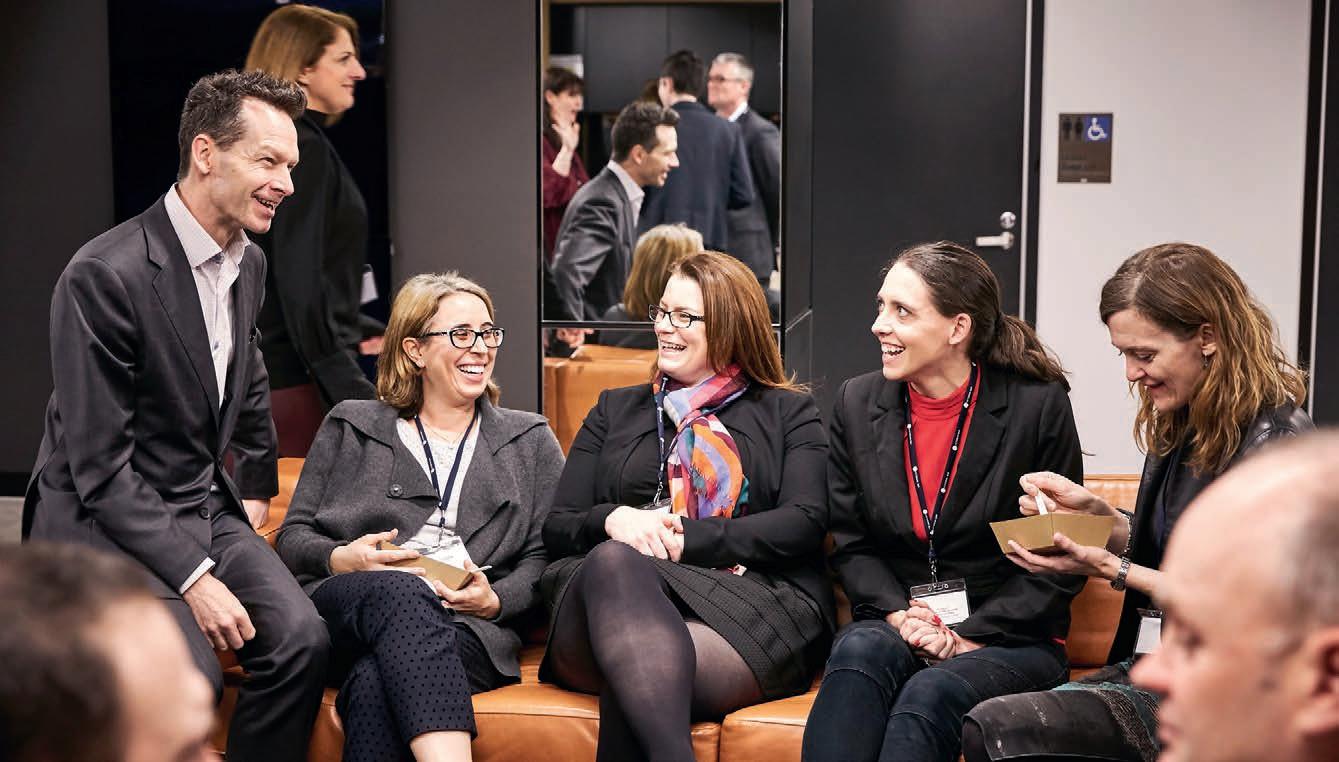
judiciary, the Bar and beyond, almost all of whom donate their time.
In August, more than 200 Victorian law students attended the Victorian Bar’s inaugural Open Day to learn about career opportunities as a barrister. The Open Day was oversubscribed, with law students from all major Victorian universities applying to participate.
Partnering with the City of Hume, the Victorian Bar Foundation recognised the top performers in year 11 Legal Studies from 16 schools in the Hume City Council area with the Victorian Bar Foundation Student Achievement Awards. Sixteen winners were awarded a cash prize of $1,500, and a total of 48 students have been offered a personal mentoring opportunity with members of counsel, to assist them in assessing a possible future career at the Victorian Bar.
In 2018, we also launched the Victorian Bar branch of the Law Library of Victoria in the Richard Griffith Library in Owen Dixon Chambers East. Incorporating the Victorian Bar’s library into the Law Library of Victoria furthers the Bar Council’s objectives of providing services to members to support and enhance their practices, and fostering excellence and enhancing the performance of Victorian barristers. This exciting initiative means that, for the first time, members of the Victorian Bar have access on a 24/7 basis to the very same online research tools that are available to members of the Victorian judiciary—resources that will further lower barriers to entry to those coming to the Bar and improve those available to
every member. Our agreement with the Law Library of Victoria has also led to improvements to our hard copy collection, an increase in borrowing rights from the Supreme Court Library, improved research support, and the presence at advertised times of trained librarians in the Richard Griffith Library.
This year the Victorian Bar has made important progress in increasing diversity and inclusion.
The ‘State of the Victorian Bar’ survey findings demonstrated clearly that the Bar is increasingly culturally diverse—15 per cent of Victorian barristers were born overseas in more than 30 countries; while members speak more than 37 languages with nine per cent speaking a language other than English at home. Strides towards true gender equality have been made, with women now comprising more than 29 per cent of Victorian barristers compared to less than six per cent in 1980. More than 40 per cent of barristers under 15 years’ call are women and more women barristers are earning higher incomes.
The Bar’s commitment to promoting diversity and inclusion in the legal profession is demonstrated in many ways. One matter upon which focus was placed this year was the Bar’s endorsement of the Law Council of Australia’s Equality and Diversity Charter and Equitable Briefing Policy. More Victorian barristers have adopted the Equitable Briefing Policy than in the rest of the nation combined, formalising their commitment to ensuring that briefing recommendations take into account the full array of talent available at the Victorian Bar. The ‘State of
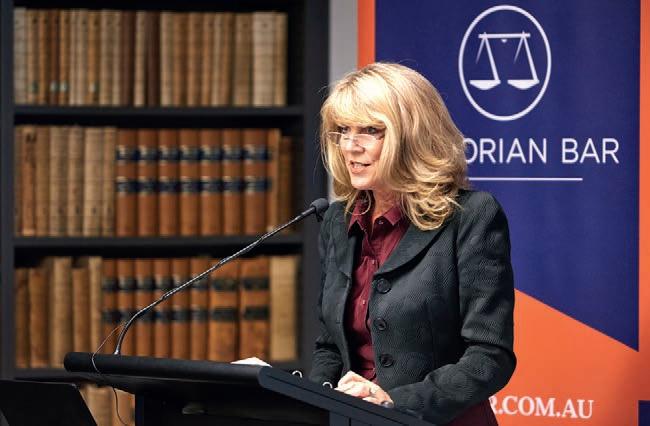
In October, around 150 members of the legal profession gathered in the Neil McPhee room to launch the Bar’s LGBTI Working Group’s online support resource, which has been designed to assist lawyers in tackling discrimination that may be faced by lesbian, gay, bisexual, transsexual and intersex persons in the workplace. The resource is part of the Victorian Bar’s commitment to ensuring that the Bar is a centre of legal excellence where the best and brightest are welcome and can thrive, whatever their background or circumstances. It provides all members of the profession with practical examples, information and strategies to support their practices and colleagues.
the Victorian Bar’ survey showed that members of the Victorian Bar recommend that women barristers, and particularly junior women barristers, be briefed in numbers significantly higher than their representation at the Bar.
The Victorian Bar has been active in implementing measures to improve gender equality since at least 1998, including via our nation-leading parental leave subsidy, which has now been in place for more than 20 years. We are leading the other Australian Bars in gender equity measures. We have real momentum that we must continue to drive.
Additional initiatives to support the retention of women at the Bar include unconscious bias awareness training, return to work programs and regular reporting on demographics and exit surveys.
The Victorian Bar also has a range of measures designed to assist Indigenous Australians to enter and remain in the legal profession, including a Reconciliation Action Plan, Indigenous Clerkship Program, Student Mentoring Program, Student Work Experience Program, Indigenous Barristers’ Fund, Indigenous Barristers’ Development Fund and chambers subsidies for Indigenous barristers. It was a particular thrill this year to learn that one of our members, Tim Goodwin, had been named the Australian 2018 National Indigenous Legal Professional of the Year.
In July, we launched new and strengthened policies and procedures on discrimination, bullying and sexual harassment, which make it clear that this is unacceptable conduct at the Victorian Bar. Our policies are a clear statement of the Bar’s values. We have enhanced the grievance mechanisms that are available to members, including via new complaints and reporting mechanisms. A number of eminent barristers have been nominated by Bar Council as Bar Conciliators to assist in implementing the new conduct policies. The Bar Conciliators have received training from the Victorian Human Rights and Equal Opportunity Commission.
This year the Victorian Bar also established a cultural and linguistic diversity working group, to assist the Bar Council in understanding the challenges faced by barristers from culturally diverse backgrounds, and to develop resources for all members of the Victorian Bar.
In May, I was honoured to speak at the Muslim Legal Network’s annual Iftar (breaking of the fast) dinner, the first time that a Victorian Bar President has done so.
All of these activities reflect the view that the Bar should reflect the community that it exists to serve and be a welcoming workplace for the best and brightest legal talent, regardless of background.
Finally, the ‘Changing Face of the Bar’ exhibition, opened in September, showcased 700 photographs that tell the rich story of the dynamic and diverse modern Victorian Bar. Opened by renowned photographer, Bill Henson, the photo exhibition by Garth Oriander at the Peter O’Callaghan QC Gallery contrasted today’s Bar with the Victorian Bar of the 1930s and 1980s. More than 700 currently practising barristers were photographed, in everything from surf life-saving gear and sporting lycra to formal robes. This exhibition was a graphic testament to our collegiality, diversity and humanity, uniting our most senior and revered members, Chairmen and Presidents past and present, and our newest advocates.
The Victorian Bar has always supported the health and wellbeing of its members through a range of formal and informal measures, and has been a national leader in understanding the stressors that affect members of the profession. This year we launched an online survey to build on our understanding of the prevalence of wellbeing issues at the Bar and the contexts in which they occur. The findings of the ‘Wellbeing at the Victorian Bar’ survey, conducted with the assistance of the University of Portsmouth, will be used to build on support programs for members.
Headline results were favourable and encouraging, including that 73% of respondents were satisfied with their overall quality
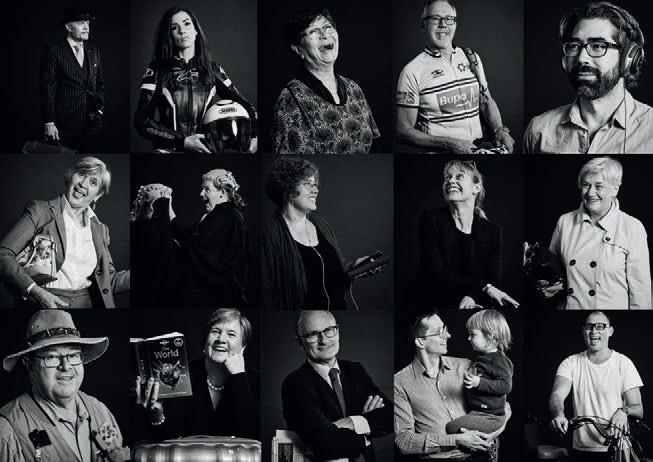
We are proud of the pro bono work done by members of the Bar. Such work is seen by most barristers as a way of putting back into the community. It is difficult to measure the value of the contribution that our members make by way of pro bono service, but we can confidently predict that it is worth the equivalent of many millions of dollars per year. We know from the ‘State of the Victorian Bar’ report that 44 per cent of members undertook more than 20 hours of pro bono work in a six-month period in 2017. These contributions are too often unheralded, and yet can make the most profound difference to the lives of those who are assisted.
O’Brien QC Bottom row: John Hall, Jennifer Batrouney QC, Paul Santamaria, Olaf Ciolek, Stephen Jurica
of working life and 79% felt that overall, taking everything into consideration, they felt satisfied with their jobs. Less positively, far too many of us experience stress at work and do not get the sleep we need every night.
In addition to survey questions related to job satisfaction and personal wellbeing, data was also captured on discrimination (gender, race, disability and other forms), bullying and harassment encountered by barristers. While in most respects the results are below benchmarks in the legal profession and the broader community, some of the findings are concerning. However, we carried out the survey, in part, to better understand issues and develop strategies to address them, and that is exactly what we are doing, through our support services, training and working groups.
Among other matters, the results have already led to the development of an Australian-first Judicial Conduct Policy. The policy outlines the standards of judicial conduct that members are entitled to expect, sets out available (and improved) grievance and reporting mechanisms, and introduces the Bar’s first Judicial Conduct Advisers—eminent members of the Bar who are available as a support and to give advice in relation to judicial conduct experienced or witnessed by members. At the time of writing, a protocol for raising and resolving complaints of inappropriate judicial conduct was being developed jointly by the Chief Justice of the Supreme Court, the Hon Anne Ferguson and the Bar. It is hoped that that protocol will be adopted by all courts and tribunals in Victoria, prescribe a less formal mechanism for raising grievances than that available through the Judicial Commission of Victoria, and lead to improvements in judicial conduct. It is a fine example of collaboration between the Bench and the Bar on a matter where our interests—and values—entirely coincide.
Our pro bono duty barrister schemes with Victoria’s courts and tribunals have been comprehensively reviewed this year, with the objective of consolidating and streamlining our disparate programs and relaunching a more effective and efficient system, managed via a new online portal. Working with the County Court, in October we launched a new pilot scheme for pro bono referrals. While work is ongoing, the result will be an improved experience for barristers undertaking pro bono work, leading in turn to better outcomes for both courts and clients.
The Victorian Bar is a constituent member of the two national representative bodies of the legal profession, the Law Council of Australia and the Australian Bar Association. We have been active in both organisations this year. Justin Hannebery has served as the Bar’s director of the LCA under the presidency of Morry Bailes, while Jennifer Batrouney QC and I have served as directors of the ABA under the presidency of Noel Hutley SC. I have particularly benefited from my role as a director of the ABA this year, getting to know and working with my counterparts at each of the other Australian independent Bars on matters that affect our branch of the profession.
In November, sadly, we will farewell our CEO Sarah Fregon who, in almost four years, has created an outstanding legacy, having overseen restructure, modernisation, strategic implementation and improved corporate governance. The Bar is an entirely different and more professional organisation thanks to Sarah’s leadership.
Our new CEO, Katherine Lorenz, joins us from Monash Health. She has exceptional leadership skills and a keen strategic and business mind. Katherine will build upon Sarah’s legacy and lead the execution of the Bar Council’s strategy to face the challenges posed by the constantly changing and disrupted market for legal services.
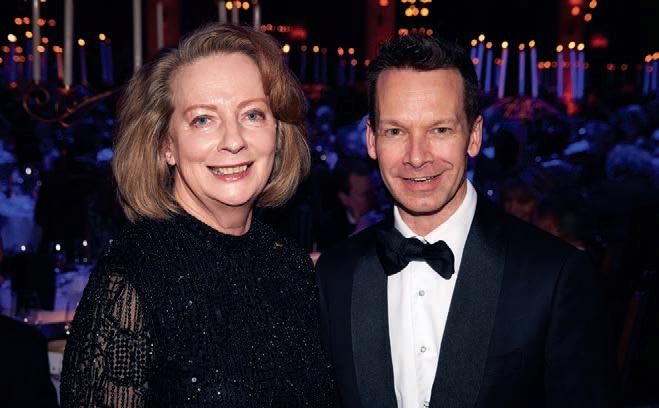
One of the most rewarding aspects of being President is working together with others, pretty much every day, on projects to improve the standing of the Bar and opportunities for and the welfare of our members. All positions on Bar Council, its committees and working groups are voluntary, but such is the spirit of collegiality at the Bar that we are never short of members willing to lend their skills, experience and valuable time and for this I am extremely grateful.
And so, there are many people I would like to thank for the invaluable contributions they have made this year to the Victorian Bar and its members. Firstly, I would like to thank Chief Justice Ferguson (and her chambers) for her valued work in the task of appointing silks. This is an enormous exercise that substantially contributes to confidence in the administration of justice in Victoria. Thanks, too, to the Hon Stephen Charles AO QC who chairs the Preliminary Evaluation Committee that provides advice to the Chief Justice in connection with the appointment of silks.
Thank you to Jennifer Batrouney QC for her leadership and hard work, not only in her term as President in 2017 but over many years of exemplary service both in Victoria and on the Australian Bar Association. Her presence on Bar Council is missed.
Thank you to those who retired from Bar Council at the last election: Peter Chadwick QC, Chris Winneke QC, Elizabeth Brimer, Daniel Crennan QC, Karen Argiropoulos and Daniel Bongiorno. I also thank the Honourable Justice Michelle Quigley who retired upon her appointment to judicial office.
My thanks to Paul Anastassiou QC, Chairman and Paul Clark, CEO of Barristers’ Chambers Limited for their strong leadership and performance; and thank you to BCL’s former Chairman, Michael Wyles QC for his term at the helm.
Sincere thanks to all the committees and working groups who devote so much time behind the scenes. And to the editors and committee of the Victorian Bar News for their outstanding publications.
Our Bar Office, under CEO Sarah Fregon, ably assisted by General Manager Member Services Rachel Chrapot and General Manager Corporate Services Amanda Utt, provides a very high standard of support to the Bar Council and all members of the Bar. I thank all staff for their valuable contribution and dedication throughout the year.
This year’s Bar Council has been cohesive and collegiate, with almost all decisions made by consensus. All members have made significant contributions, but it would be remiss of me not to single out the members of the Executive (Senior Vice-President Wendy Harris QC, Junior Vice-President Simon Marks QC and Treasurer Sam Hay), and our Honorary and Assistant Honorary Secretaries (Nicole Papaleo and Andrew Bell) for their unflagging enthusiasm, support and commitment to our Bar. I have relied heavily on their wise counsel and support throughout the year.
Finally, my thanks go to Ross Nankivell and James Talia who draft almost all of the many speeches that I deliver in my role as President (the number this year has been eye-watering), and to my Executive Assistants Denise Bennett and Liz Barr, and the CEO’s Executive Assistant Elizabeth Ingham, without whom, among other things, I would not know at any given time where I am supposed to be, how I am supposed to get there, or what I am supposed to do on arrival.
It has been a privilege to serve as President of the Victorian Bar. We are a centre of excellence for legal talent, attracting people who see the law not just as a means of making a living, but as a way of shaping a better society. By adhering to the core values that have always defined the Victorian Bar—particularly independence, excellence and leadership—and by strong and authoritative advocacy of those values in the profession and the community, we can be optimistic that our Bar will continue to thrive in a rapidly changing world.

Dr Matthew Collins QC President
Key website insights from 1 July 2017 - 30 June 2018
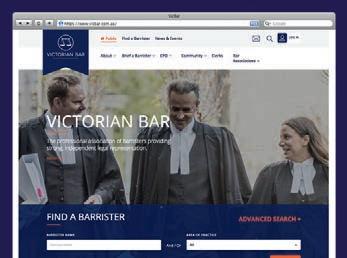

Total website visits
1,646,012
+7.02% compared to the previous period
Visits via social media
10,021
+85.03% compared to the previous period









Tablet users
101,480
+50.76% compared to the previous period
Unique website visits
522,254
+7.58% compared to the previous period









Desktop users
1,167,347
+4.60% compared to the previous period


Mobile users
377,185
+6.34% compared to the previous period
Visits via organic search
1,292,729
+8.34% compared to the previous period

The “Find a Barrister” search feature was used 219,529 times



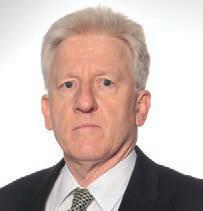
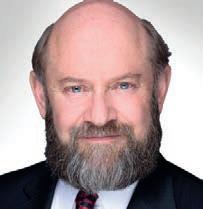


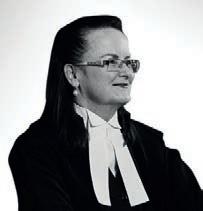
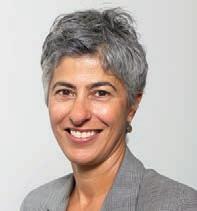

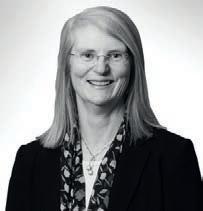




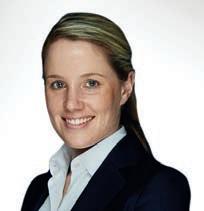








Chief
Sarah


General
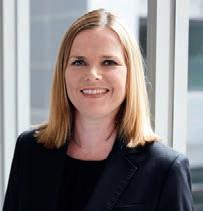
General



Manager



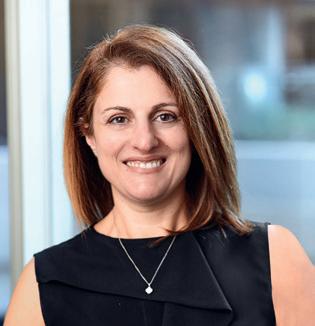








Children’s Court Bar Association
Melissa Stead (President)
Christine Pollard (Secretary)
Arna Delle-Vergini (Honorary Treasurer)
Randall Kune
Samantha Renwick
Vicky Marty
Judy Benson
Commercial Bar Association
Wendy Harris QC (President)
Nick Hopkins QC (Senior Vice President)
Luke Merrick (Junior Vice President/Convenor)
Stewart Maiden QC (Treasurer)
Paul Hayes QC
Claire Harris QC
Oren Bigos
Elizabeth Boros
Meg O’Sullivan
Gabi Crafti
Kieran Hickie (Honorary Secretary)
Georgia Berlic (Deputy Honorary Secretary)
Common Law Bar Association
Ross Gillies QC (Chairman)
Mary Anne Hartley QC (Treasurer)
David Martin (Secretary)
Richard Stanley QC
Tim Tobin QC
Fiona McLeod SC
Michael Wheelahan QC
James Mighell QC
Andrew Clements QC
Róisín Annesley QC
Jacinta Forbes QC
Áine Magee QC
Michelle Britbart QC
Simon McGregor
Fiona Ellis
David Purcell
Patrick Over
Gavin Coldwell
Stephen Jurica
Stella Gold
Julia Frederico
Raph Ajzensztat
Daniel Nguyen
Compensation Law Bar Association
Ian McDonald (Chairman)
Anthea MacTiernan (Secretary)
Ray Ternes (Treasurer)
Michael Richards
Bruce McKenzie
Steven Carson
Nick Horner
Sascha Dawson
Kim Bradey
Megan Tait
Criminal Bar Association
Lesley Taylor QC (Chair)
Daniel Gurvich QC (Vice Chair)
Simon Moglia (Treasurer)
Megan Tittensor (Secretary)
Anthony Lewis
Michelle Mykytowycz
Jim Shaw
Nahrain Warda
Pardeep Tiwana
Megan Casey
Family Law Bar Association
Geoff Dickson QC (Chair)
Rohan Hoult (Deputy Chair)
Jennifer Howe (Secretary)
Robin Smith (Treasurer)
Alison Burt (CPD Co-Coordinator)
Caroline Paterson
Gerry Holmes
Rory McIvor
Industrial Bar Association
Richard Dalton (President)
Steven Moore QC (Senior Vice President)
Catherine Symons (Vice President)
Rohan Millar (Treasurer)
Andrew Bell (Secretary)
Paul O’Grady QC
Craig Dowling SC
Mark Irving QC
Gerard McKeown
Dr Victoria Lambropoulos
Marc Felman
Robert O’Neill
Kate Burke
Yasser Bakri
Andrew Denton
Rebecca Preston
Migration Law
Bar Association
Guy Gilbert SC (Chair)
Georgina Costello (Vice-Chair)
Matthew Albert
Angel Aleksov
Military Bar Association
The Honourable
Alex Chernov AC QC (Patron)
The Honourable Marilyn
Warren AC QC (Patron)
Paul Panayi (Chairman)
Benjamin Gibson (Treasurer)
John T (Jack) Rush
RFD QC (Navy Patron)
Major General the Honourable Justice
Richard RS Tracey
AM RFD (Army Patron)
Andrew J Kirkham
AM RFD QC (Air Force Patron)
Tax Bar Association
Michael T Flynn QC (President)
Terry Murphy QC (Vice President)
Daniel J McInerney (Treasurer)
Hadi Mazloum (Secretary)
Andrew Broadfoot QC
Fiona Alpins
Michael Y Bearman
Dr Julianne E Jaques
F John Morgan
Eugene F Wheelahan
Ria Sotiropoulos
Angela Lee (CPD Coordinator)
Kateena O’Gorman
Annette M Charak
Claire V Nicholson (Communications Officer)
Dr Ben Gauntlett
Anna R Wilson
Fiona R Cameron (Communications Officer)
Gareth J Redenbach
Women’s Barristers
Association
Kylie Weston-Scheuber (Convenor)
Georgia S J Berlic (Assistant Convenor)
Sandra Karabidian (Assistant Convenor)
Jessica F Swanwick (Secretary)
Joye S Elleray (Treasurer)
Jennifer J Batrouney QC
Sashi Maharaj QC
Kim J Knights
Shivani Pillai
Susan Aufgang
Emma Peppler
Diana Price
Alex C Burt
Louise J Martin
Natalie J Blok
Astrid M Haban-Beer
Bridget E Slocum
Christie M Jones
Edwina Keynes
Retiring Committee members: Natalie Sheridan-Smith as Secretary until 8th December 2017.
The Children’s Court Bar Association is comprised of dedicated Counsel who work in a unique area of law that is dynamic, challenging and rewarding.
The jurisdiction has quickly adapted to significant changes to care orders implemented by amendments to the Children Youth and Families Act 2005 that took effect in March 2016. The jurisdiction continues to rapidly evolve in response to ongoing, highly contentious and highly topical issues including the prevalence of family violence in the community.
The CPD program is now focussing on better educating our members in relation to multi-disciplinary medical and psychiatric research in addition to new therapeutic and practical initiatives directed in protecting children from exposure to trauma and family violence. Mr Kune and Ms Stead from our committee were on the organising committee of an Ethics, Courtcraft and Advocacy Seminar Series held at the Children’s Court in Melbourne. Some of the topics were:
› Overview of Youth Control Orders/ Bail Amendments, › Urine Drug Screening and Interpretation
In November last year, the Association hosted a CPD session on Psychological assessments with Fraser Gough as the speaker. Also in November, the Association hosted a seminar chaired by Julian Burnside AO QC, with Dr Robyn Sampson as the speaker on Children in Immigration Detention. On 20 March this year, Ms Stead chaired a CPD session titled Self Care When Working in Challenging Environments; featuring guest speaker, William Wainwright, forensic psychologist.
In May, Ms Delle-Vergini participated in The Whitelion Bail Out event.
We are delighted that Mr Kune has recently been appointed as a Children’s Court Magistrate.
At the AGM in November 2017 the following former members of the Executive stepped down and CommBar acknowledges and thanks each of them for their substantial contribution. They are: Caroline Kenny QC, Kathleen Foley, Caryn van Proctor and Andrew Downie. Georgia Douglas also stood down as Honorary Secretary.
In April this year, Matt Connock QC, the then President of CommBar, was appointed to the Supreme Court of Victoria. This led to a reshuffling in the officebearers, with Wendy Harris QC becoming President, and Nick Hopkins assuming the role of Senior Vice President.
CommBar report
CommBar has more than 600 members with an interest in commercial law, most of whom are practising barristers. It incorporates nineteen separate specialist sections. Information regarding each section, including its Chair and members, is available on CommBar section of the VicBar website: www.vicbar.com.au.
Like previous years, the 2017 – 2018 year has been a busy one for CommBar. It prioritises active engagement with other sections of the Bar, the broader profession, the courts, universities, the judiciary, and other important stakeholders.
The activities of CommBar during the year to 30 June 2018 have reflected its purposes, which include to provide a forum for interaction and engagement between barristers with an interest in commercial law; to contribute to the development of policy and practice in the sphere of commercial law; to liaise with the courts, government, authorities and other stakeholders; to represent members on matters of concern, including by way of engagement with VicBar; to encourage the participation of members in continuing legal education and conferences which may further their knowledge and understanding of commercial law.
To this end, CommBar’s activities have included:
› Organising and hosting member functions, including the CommBar annual drinks function at the Federal Court of Australia.
› Organising the Hong Kong International Law Conference, co-hosted with VicBar and the Hong Kong Bar Association.
› Migrating the CommBar website to the VicBar site, including ensuring ongoing functionality and benefit to members.
› Liaising and consulting with various Courts regarding review of, and changes to, civil procedure rules.
› Consulting with stakeholders and participants in the CommBar Equitable Briefing program, and liaising with VicBar and others with regard to migrating the program into the now-established Law Council of Australia’s scheme.
› Preparing submissions to law reform and other bodies, including submissions on contingency fees, access to justice and litigation funding.
› Engaging with University Law Schools and the courts with respect to the hosting of joint seminar programs, as well as overseeing the CommBar CPD program.
› Refreshing sections and section office-bearers in order to ensure optimal engagement, effectiveness and regeneration, as well as providing funding and other support to the nineteen CommBar sections.
› Negotiating for the benefit of members continued subscription to Lexology, and electronic hub for legal articles, updates and analysis.
› Sponsoring various events and organisations including the Junior Bar Speaking Competition, Austlii, the CIArb Australia business lunch.
› Reviewing membership categories and establishing additional honorary categories for solicitors-general.
› Publishing CommBar’s Blog “CommBar Matters”, and, on a quarterly basis, the CommBar Newsletter.
During the year, the Common Law Bar Association has been involved in a number of activities including:
› Continued liaison with the Judges of the Supreme Court concerning the conduct of common law trials in the Supreme Court.
› The Common Law Bar Association is represented on the various User Groups including the Personal Injuries List, the Medical List and the Dust and Diseases List and “Key Points Bulletins” emanating from the Court following meetings of the various User Groups have been circulated to members.
› Continued liaising with the Bar regarding proposed submissions to the Law Reform Commission in response to its Consultation Paper – Access to Justice – Litigation Funding and Group Proceedings.
› Meeting with Judges of the County Court, including Chief Judge Kidd and Judge O’Neill together with those responsible for the listing of cases. The Court continues to liaise with the Common Law Bar Association especially concerning improvements in listing procedures and attempts to streamline the conduct of serious injury applications, including earlier listing of damages trials following successful serious injury applications.
› The provision of speakers and topics on a range of issues as part of the Bar’s ongoing CPD Program.
› Providing case summaries of recent Court decisions to its members.
› Jointly sponsoring the Australian Insurance Law Association Conference and Dinner.
› Continued discussion with the Transport Accident Commission and the Victorian WorkCover Authority concerning a variety of matters pertaining to the conduct and hearing of common law matters arising as a result of transport accidents and industrial accidents.
› Hosting a very successful dinner following the Annual Meeting in December 2017.
The number of members of the Common Law Bar Association continues to increase. Currently, there are 321 members of the Victorian Bar who are members of the Common Law Bar Association.
The Association’s current membership is 121, up from 110 at the end of last year. Bruce McKenzie’s diligent contemporaneous distribution of relevant judicial decisions from the Magistrates’, County, Supreme and High Courts continues to be of enormous assistance to those practising in the jurisdiction, and offers a compelling reason to join the Association.
Representatives of the Association, Michael Richards and Nick Horner, have continued to liaise with the Magistrates’ Court WorkCover Users’ Group on a regular basis. There was a drop of 4% in WorkCover applications issued in the Magistrates’ Court in the financial year 2017/2018, compared with 2016/2017 (1430, down from 1493).
The Association has advocated for its members with respect to various issues of concern during the year, including the use of the limited conference rooms at the Magistrates’ Court. The issue of daily fees rather than brief fees and refreshers is an issue that has had some attention, and will continue to attract scrutiny in the forthcoming financial year.
The Association held its AGM on 15 November 2017, followed by a free drinks and canapes function for its members and guests.
The Association held a farewell for outgoing Magistrate His Honour John O’Brien, on 3 May 2018. His Honour has been appointed a reserve Magistrate.
The Association continues to provide educational and professional development support to ensure that the Bar maintains its high standard of representation. The Association hosted an excellent CPD entitled ‘An introduction / refresher to workers’ compensation’, which was delivered by His Honour Magistrate Brian Wright on 22 February 2018. A further CPD has been organised for October 2018, and others will follow in 2019.
Following on from the success of a social cocktail function in March 2017, the Association is looking to hold another such function for barristers and solicitors in the jurisdiction in March 2019.
This year the Criminal Bar Association (CBA) has confronted several challenges. Our members confront the reality of “law and order” daily. We continued to try to enhance the criminal justice system of Victoria by participating in public debate and engaging with law reform bodies, the Courts and the chief briefing agencies.
The CBA’s roles included:
› Addressing the grave problem of overloading in jails. We remained active in the Victorian Custody Reference Group.
› Participation in Bail reform. As expected, new laws have worsened overcrowding in prisons and police cells. Counsel have been called upon to prepare urgent bail applications, with ever-decreasing resources to support applicants, – all for no fee if the hearing is not reached or adjourned.
› Working with the Courts to successfully implement the introduction of intermediaries, trained to assist children and vulnerable witnesses give evidence in court.
› Engagement with the Commonwealth DPP who removed daily fees for counsel during jury deliberations. The Courts have joined the CBA in reminding the CDPP that the prosecutor is in charge of the jury until verdict. The new
arrangement is contrary to the interests of justice.
› Aiding law reform in VOCAT, family violence sentencing, mandatory sentencing, standard sentencing, jury directions, restitution and compensation.
By June 2018, “law and order” was the focus in the lead up to the November State election. The CBA has responded as best it can as each new provision is enacted or proposed.
The CBA provided CPD sessions to promote the on-going excellence of our membership.
The CBA chair, Lesley Taylor Q.C. was appointed to the Supreme Court in July 2018. We wish Her Honour well. Daniel Gurvich Q.C., then Vice Chair, took over as Chair.
We have congratulated a number of other members who have taken judicial appointment in the past year. We thank the staff of the Bar Office for the support the CBA always receives.
The Association has sadly lost 2 members, Mr. Peter Davis and Mrs. Margaret Mandelert, both of whom were long time Barristers who were respected and are sadly missed. Margaret was honoured as a ‘Legend of the Bar’ given her years of service to Family Law and the Victorian Bar.
This year, the Federal government has introduced legislation into Parliament that will bring about one of the most significant changes to the structure of the Family Court/Federal Circuit Court since its inception. The Family Law Bar Association has ensured throughout this very public debate, that our members are fully informed of the position that the FLBA is taking on behalf of our members and have constantly sought their input and contributions to submissions. Our President and committee members have worked closely with other Family Law stakeholders, including Vic Bar, Law Institute of Victoria and the Law Council of Australia to ensure that the views of our members are represented to the Government.
The Association has also been working on submissions on behalf of our members to the Australian Law Reform Commission’s review of the Family Law Act 1975. This review was implemented by the Attorney General (at the time) to look at all aspects of the Family Law Act, particularly focused upon the protection of victims of family violence within the court system.
Both of the Governments reviews have required our committee to review lengthy submissions and to articulate those areas that the views of our members were aligned and where we took a different stance. The committee continues this work whilst the review and legislation are still being debated. Our Chair has been the personal representative at interstate conferences and meetings.
The FLBA has had a particular focus this year on the continuing education of our members as part of our CPD agenda. The newly created position within the committee of our
CPD coordinator has been successful in ensuring that our members are kept updated on the latest trends in legislation and social issues (such as drug testing techniques) affecting our work. We have been fortunate to have our own members imparting their knowledge and also having external experts come in to educate our members.
Our Social functions have remained a key aspect of the work of the FLBA. Ensuring that the profession comes together in a social and supportive environment is a key focus of the committee. Our annual dinners have been successful in bringing members of our judiciary and members of the bar together in a social environment.
This year we welcomed Justice Alstergren in his new positions as the Chief Justice of the Family Court, Chief Judge of the Federal Circuit Court and Chief Justice of the Family Court -Court of Appeal. We will continue to foster a relationship with His Honour to ensure the efficient running of our courts.
The IBA comprises counsel who undertake work in industrial and employment law in State and Commonwealth courts and tribunals. The number of members has increased to over 150.
During the 2017-2018 financial year the IBA co-ordinated and developed a continuing professional development (CPD) program on topics of significance to its members. The IBA continued to provide a forum for the exchange and dissemination of information relevant to its members. The IBA organised social functions to facilitate co-operation and comradery between its members and solicitors who practice in the industrial and employment field. The IBA has engaged with the courts and the Fair Work Commission (FWC) through user groups and other forums.
The events organised by the IBA during the 2017-2018 financial year included:
› a CPD seminar “Industrial Law Regulatory Compliance: Recent developments”, featuring updates on regulatory activities and issues from Natalie James, the Fair Work Ombudsman, Mark Bielecki, the Registered Organisations Commissioner and Shamim Saeedi, Director Legal, the Fair Work Building and Construction Inspectorate;
› a CPD seminar presentation by the Honourable Justice Chris Jessup and Janine Webster (the Fair Work Ombudsman’s Legal Director) on accessorial liability under the Fair Work Act 2009 (Cth) and a regulatory update provided by Cathy Cato (Acting Australian Building and Construction Commissioner);
› a CPD seminar presentation entitled “Annual Employment Law Update”, featuring updates on developments in employment law, at which the Honourable Justice McDonald, Associate Justice Ierodiaconou, Siobhan Kelly, Natalie Campbell and Paul O’Grady QC spoke;
› a CPD seminar entitled ‘Regulators’ Update: Regulatory
Priorities and Approach to Civil Penalties’ delivered by Stephen McBurney (Australian Building and Construction Commissioner), Mark Bielecki (Registered Organisations Commissioner), Janine Webster (Director, Legal, Fair Work Ombudsman) and Catherine Symons.
› the Annual Dinner held at the Essoign Club, at which the Honourable Dr Chris Jessup was our honoured guest speaker to mark his retirement from the Federal Court and Rachel Doyle SC gave the introductory speech.
The IBA supported the Victorian Bar Health and Wellbeing Project by attending the launch and encouraging IBA members to complete the survey, and supported the Law Council of Australia’s Equitable Briefing Policy by encouraging IBA members to adopt it.
The IBA thanks its members and supporters for their contribution to developing learning and co-operation within the industrial and employment jurisdiction.
The last year has been a busy one for the Association. It has presented CPD events for its members, on a range of topics which are of interest to those practising in this specialist area. Interested solicitors have been welcome. The Association also co-sponsored a CPD event with the Human Rights Law Committee. These events have been well attended.
From time to time during the year, members of the Association have sent a group email to alert others to an important case which had been handed down, or a change in legislation. Because it is very difficult to keep up with the large number of cases which are delivered on a daily basis, and the many amendments to the Migration Act and Migration Regulations, this has been a great service to members.
Members attended a lunchtime meeting at the Federal Circuit Court as part of a round table discussion for stakeholders in the migration arena. The Court was in the process of drafting new Practice Rules in the migration jurisdiction, and was keen to consult those who regularly practice there. Other attendees included solicitors from migration firms, Victoria Legal Aid, and the Asylum Seekers Resources Centre.
The demand for pro bono assistance was ever present during the year. Many members of the Association have made a major contribution. The Federal Circuit Court and Federal Court Registrars have often asked members to advise an unrepresented litigant, and appear if there was sufficient merit. A more recent area has been in assisting with a caseload of people who arrived on Ashmore Reef (off the coast of northwestern Australia). Another has been appearing for various asylum seekers on Nauru who have sought to come to Australia for medical treatment.
The Association also assisted the Bar in drafting a press release in support of members of the Administrative Appeals Tribunal who were facing sustained criticism in the media.
Committee at 30 June 2018: The Honourable Alex Chernov AC QC (Patron), The Honourable Marilyn Warren AC QC (Patron), Paul Panayi (Chairman), Benjamin Gibson (Treasurer), John T (Jack) Rush EFD QC (Navy Patron), Major General the Honourable Justice Richard RS Tracey AM RFD (Army Patron), Andrew J Kirkham AM RFD QC (Air Force Patron)
The Committee thanks those members who retired during the year. The Committee also thanks Michael Flynn QC for his contribution to the Tax Bar Association during his two-year term as president. Finally, the Committee thanks Hadi Mazloum for preparing this report.
Highlights of the Financial Year included:
› Membership increased to 119.
Provided a number of CPD seminars on a range of topics, including:
› The Magic of Sandini: Obtaining Tax Certainty via Declaratory Relief – 20 September 2017 – delivered by Andrew Broadfoot QC and Gareth Redenbach;
› An ATO Registry of Trusts and Trust Assets – 9 October 2017 –delivered by John Glover, chaired by Michael Flynn QC;
› Lewski v Commissioner of Taxation – 12 December 2017 –delivered by Claire Nicholson and Anna Wilson, chaired by Andrew Broadfoot QC;
› Q&A Session with Fiona Cameron & Michael Bearman – Tax Implications in Judgments & Settlements – 18 March 2018;
› Ethical Considerations Affecting Government Litigants – 22 March 2018 – delivered by Meredith Schilling, Katherine Brazenor and Matthew Meng, chaired by Michael Flynn QC;
› Resource Capital Fund IV v Commissioner of Taxation – 3 May 2018 – delivered by Gareth Redenbach and James Strong, chaired by Andrew Broadfoot QC;
› Tax Implications for the Vesting of Trusts – 14 May 2018 –delivered by Mia Clareborough, chaired by Terry Murphy QC;
› The Full Court Decision in Sandini: Tax Implications for Family Law Disputes & Rollover Provisions – 21 May 2018 – delivered by Gareth Redenbach, chaired by Michael Flynn QC;
› Organising various CPDs and social functions in partnership with the ATO & SRO as well as tax groups in law and accounting firms.
Fiona Cameron created a new stand-alone website for the Association: www.taxbar.asn.au. The website showcases member profiles, includes papers presented by barristers and other tax professionals, an easy search tool for a tax barrister, links to research material and notices of forthcoming seminars and social events.
Created a Tax Bar Brochure, showcasing the profile and CV of interested members which was distributed at the Tax Bar
Association annual dinner and other functions to solicitors and potential clients. It is also available for download from the Tax Bar website.
Worked closely with the AAT to develop and implement a pro-bono scheme to mirror that of the superior Courts so as to facilitate access to justice for those in need.
Consultation
Michael Flynn QC consulted with the Supreme Court Rules Committee regarding the review of the Supreme Court Rules and the application of the Rules to tax matters.
Michael Flynn QC consulted with the Law Council of Australia on credit reporting legislative changes (Treasury Laws Amendment (Tax Transparency) Bill 2018), a proposed amendment to the law that will allow the ATO to report a taxpayer to a credit reporting agency if they have a taxation debt of more than $10,000.
The TBA Communications Officers sent out a regular electronic newsletter, informing members, and subscribers from legal and accounting firms, the Australian Taxation Office, and universities, of the latest tax developments.
Organised discounted memberships to the above publications for TBA members.
Hosted a number of social events to foster relationships between Association members and the broader tax community including a lunch to welcome former Justice Pagone to the Victorian Bar on his retirement from the Federal Court.
The 2017 annual dinner in December had as its guest speaker former Justice Pagone of the Federal Court and the 2018 annual dinner will have as its guest speaker Justice Steward of the Federal Court.
WBA Convenor’s report in relation to activities for 2017/2018:
› WBA currently has 266 members, of whom 234 are fee paying (the remainder being judicial members and readers). This is compared to around 220 members in the previous financial year.
› WBA, together with VWL, organised a function in celebration of the former Chief Justice Marilyn Warren on her retirement from the Supreme Court. Her Honour, who has been the Patron of WBA, accepted Honorary membership of WBA (Sept 2017).
› The Honourable Justice Pamela Tate kindly accepted our invitation to be the new patron of WBA. We look forward to having the benefit of her Honour’s guidance in the coming years.
› WBA participated in a working group organised by the Bar’s Equality and Diversity Committee to develop a set of working
documents for the implementation of the Law Council of Australia’s Gender Equitable Briefing Policy. WBA will be working actively over the coming 12 months to promote the GEBP and encourage members and non-members to sign up to the GEBP and promote ways in which members can benefit from the Policy.
› WBA initiated a project to record appearances by gender in the Victorian Supreme Court. Statistics for the Court of Appeal (appearance and speaking) are, as of earlier this year, being published on the Court of Appeal website, however statistics for other jurisdictions are not currently available.
› WBA organised a Court of Appeal advocacy development program for the second year running, in conjunction with Justice Tate and the Court of Appeal (May 2017).
› WBA organised a “Women in Wine” networking event for members and their invited solicitors, hosted by Clare Burder of “The Humble Tumbler” and attended by women winemakers from regional Victoria (August 2017).
› WBA organised a networking skills event entitled “Handshake to Hello” presented by Kath McCarthy (August 2017).
› WBA, together with VWL, coordinated a “speed dating” networking event to provide barristers and solicitors with the opportunity to connect (August 2017).
› WBA and the Asian Australian Lawyers Association combined to present a panel discussion (October 2017). Thanks to Jing Zhu for her work in organising this.
› WBA co-hosted the “Coming to the Bar” Event with VWL (Oct 2017).
› WBA initiated a series of members-only events entitled “Dealing with Difficult People”. Two sessions have been presented. Thanks to Susan Aufgang and Samantha Renwick for their work in organising.
› WBA hosted its annual “Leaps and Bounds” Event celebrating a number of judicial, tribunal and silk appointments (December 2017).
› WBA continued to encourage members to apply for Bar Council and silk and ran a session on career development.
› WBA took part in the mentoring program with VWL.
› WBA sponsored attendance at the AWL conference.
› WBA promoted a range of other events that were of interest to members.
› Thank you to everyone who has been involved on the Committee for the past year.
Other thank yous
› Thank you to law student Heather Trewin, who carried out the daunting task of sorting and collating WBA’s voluminous historical correspondence and documentation.
› Thank you to law students Mary Connellan, Gabby Maginness, Audrey Rhodes, Kristen Tan, Heather Trewin and Genevieve Trinh for their excellent work in carrying out research for the WBA Gendered Court Appearances statistics project.

Alternative Dispute Resolution Committee
Art & Collections Committee
Audit & Finance Committee
Continuing Professional Development Committee Counsel Committee
Education and Professional Development Committee
Equality & Inclusion Committee Ethics Committee
Health & Wellbeing Committee
Human Rights Committee
Indictable Crime Certificate Committee (ICCC)
Indigenous Justice Committee
Innovation & Technology Committee
International Advocacy Training Committee
International Arbitration Committee
Library Committee
New Barristers’ Committee
Practising Past Chairman’s’ Committee
Pro Bono Committee
Readers’ Course Committee
Student Engagement Committee
Victorian Bar News Editorial Committee
Alternative Dispute Resolution Committee
Tony Neal QC (Chair)
Tony Elder (Deputy Chair)
Tony Nolan QC
Caroline Kenny QC
Carolyn H Sparke QC
Dr Peter FJ Condliffe
Marianne TH Barker
Danielle Huntersmith
Dr C Elizabeth Brophy
Michael JF Sweeney
Glen Pauline
John Hall
Belle Lane
Angela O’Brien
Gerard O’Shea
Art & Collections Committee
Peter Jopling AM QC (Chair)
Campbell Thomson
Siobhan Ryan
Eliza Holt
Charles Parkinson
Stephen Jurica
Edward (Eddy) Gisonda
Raini Zambelli
Daniel Kinsey
Nicholas Modrzewski
Audit & Finance Committee
Sam Hay (Chair, Honorary Treasurer)
Stewart Maiden QC (Deputy Chair, Asst. Honorary Treasurer)
Dr Ian Freckelton QC
Andrew Broadfoot QC
Julia Frederico
Sarah Fregon (Chief Executive Officer)
Susan Lawrence (Finance Manager)
Continuing Professional Development Committee
Dr Michael D Rush (Chair)
Dr Oren Bigos (Deputy Chair)
Jacinta Forbes QC
Lisa De Ferrari SC
Erin J Gardner
Justin Castelan
Richard P Dalton
Stephen Warne
Leana Papaelia
Rachel Walsh
Rachel Chrapot (General Manager, Member Services)
Bianca Stajcic
Nina Massara
Counsel Committee
Áine Magee QC (Chair)
Simon Marks QC
Wendy Harris QC
Jacinta Forbes QC
Fiona Ellis
Sam Hay
Barbara Myers
Nicole Papaleo (Honorary Secretary)
Andrew Bell (Asst. Honorary Secretary)
Education and Professional
Development Executive
Simon E Marks QC (Chair)
Philip D Corbett QC
Adrian J Finanzio SC
Dr Michael D Rush
Rachel Chrapot (General Manager, Member Services)
Equality & Diversity Committee
Jacinta Forbes QC (Chair)
Kim Knights (Deputy Chair)
Helen Rofe QC
Grant Atkinson
Sarah Thomas
David Klempfner
Jenny Firkin
Alanna Duffy
Susan Aufgang
Carl Moller
Philip Teo
Reiko Okazaki
Christopher McDermott
Ethics Committee
Róisín Annesley QC (Chair)
Peter Chadwick QC (Deputy Chair)
E Noel Magee QC
Jeremy St John QC
James Delany QC
Dr Ian Freckleton QC
Andrew Strum QC
Stewart Maiden QC
Peter Rozen
Andrew Palmer
Charles Shaw
Melissa Mahady
James Barber
Lisa Hannon
Simon Pitt
Justin Wheelahan
Sarah Cherry
Health & Wellbeing Committee
Philip Corbett QC (Chair)
Mary Anne Hartley QC (Deputy Chair)
Greg Ahern
Caroline Jenkins
Kaye McNaught
Bronia Tulloch
Emma Swart
Daniel Harrison
Gemma-Jane Cooper
Emily Porter
Natalie Campbell
Travis McKay (ex-officio)
Kirstin Green BCL (ex-officio)
Human Rights Committee
Peter G Willis SC (Chair)
Tomaso Di Lallo (Deputy Chair)
Tim Maxwell (Secretary)
Kate Bowshell (Assistant Secretary)
Malcolm Harding
Aggy Kapitaniak
Anthony Krohn
Russell Moore
Michelle Mykytowycz
Maria Pilipasidis
Andrew Yuile
Roshan Chaile
Crime Certificate Committee (ICCC)
The Hon Stephen Charles AO QC (Chair)
The Hon Robert Redlich QC (Deputy Chair)
Paul Holdenson QC
Michael Cahill SC
Simon Marks QC
Mandy Fox QC
Wendy Harris QC
Lesley Taylor QC
Rachel Chrapot (General Manager, Member Services)
Jayne Sandri (In-House Counsel and Governance Lawyer)
Indigenous Justice Committee
Anne M. Sheehan (Chair)
Timothy B Goodwin (Deputy Chair)
Jennifer J Batrouney QC
Thomas P Keely SC
Peter G Willis SC
Christopher J Winneke QC
Campbell F Thomson
Richard B C Wilson
Penny A Harris
Marita Foley
Raymond Gibson
Elizabeth Bennett
Elizabeth Ruddle
Innovation & Technology Committee
Garry Bigmore QC (Chair)
Rachel Walsh (Deputy Chair)
Donald J Farrands
Susan K Gatford
Robert W O’Neill
Julia Frederico
Raph H Ajzensztat
Andrew P Yuile
Natalie J Campbell
Zac de Kievit
International Advocacy Training Committee
Philip D Corbett QC
Sally Flynn QC
Maya Rozner
Hilary F Bonney
Jim H Shaw
James (Jim) Doherty
Trevor Wallwork
Paul P Kounnas
Emma Peppler
Nicholas Goodenough
Rachel Chrapot (General Manager, Member Services)
International Arbitration Committee
Martin R Scott QC (Chair)
Michael H Whitten QC (Deputy Chair)
Michael D G Heaton QC
Caroline Kenny QC
Anton P Trichardt
Joel J Harris
Raini Zambelli
James Waters
Andrew McRobert
Library Committee
Ian Upjohn CSC QC (Chair)
Richard Brear (Deputy Chair)
Peter Willis SC
Mark Irving QC
Melanie Baker (Secretary)
Jonathon Wilkinson
Ray Ternes
Andrew Burnett
New Barristers’ Committee
Sandra Karabidian (Chair)
Fleur Shand (Secretary)
Kevin F. Jones
John Lai-Mun Leung
Joel Silver
Daniel Nguyen
Rebecca Howe
Amelia Hughes
Samantha Renwick
Matthew Meng
Practising Past Chairmen & Presidents’ Committee
Andrew J Kirkham
AM RFD QC
The Hon Susan M Crennan
AC QC
Neil J Young QC
John T (Jack) Rush RFD QC
David E Curtain QC
Michael W Shand QC
Michael J Colbran QC
Jennifer J Batrouney QC
Paul E Anastassiou QC
James W S Peters QC
Fiona M McLeod S.C.
Pro Bono Committee
Richard Wilson (Chair)
Meredith Schilling (Deputy Chair)
Claire Harris QC
Tom Danos
Fiona Ellis
Andrew Hanak
Michael Rivette
Ben Ihle
Meg O’Sullivan
Simon Moglia
David Yarrow
Matthew Albert
Viola Katotas
Georgia Berlic
Sarah Zeleznikow
Jason Saultry (Justice Connect)
Tina Turner (Justice Connect)
Readers’ Course Committee
Simon E Marks QC (Chair)
Adrian J Finanzio S.C. (Deputy Chair)
The Hon. Raymond A Finkelstein AO QC
Dr Suzanne B McNicol QC
Carolyn H Sparke QC
Michael I Borsky QC
Lisa Nichols QC
Elizabeth M Brimer
Sarah Porritt
Justin S Graham
Eugene F Wheelahan
Aphrodite Kouloubaritsis
Diana Price
Mark P Costello
Christopher J Tran
Mark Hosking
Rachel Chrapot (General Manager, Member Services)
Wendy Pollock (Readers’ Course Coordinator)
Katherine Brazenor (Co-Chair)
James Waters (Co-Chair)
Amanda Burnnard (Co-Secretary)
Alison Burt (Co-Secretary)
David Purcell SC
Penny Marcou
Andrew Kirby
Sebastian Reid
Shaun Ginsbourg
Erin Hill
Gerard O’Shea
Samantha Renwick
Victorian Bar News
Editorial Committee
Natalie Hickey (Editor)
Justin Wheelahan (Editor)
Annette Charak (Editor)
Maree Norton (Deputy Editor)
Georgina Schoff QC
Georgina Costello
Brad Barr
Jesse Rudd
Catherine Pierce
Justin Hooper
Georgie Coleman
Campbell Thomson
The Committee exercises oversight over budgeting and annual reporting, including meeting with the auditors where necessary. Members of the Committee have access to monthly financial and variance reports and the Committee engages directly with the Bar Office regarding financial performance and projects that require funding.
With the CEO and Finance Manager’s assistance, the Committee has been involved in a number of steps aimed at ensuring financial (and other) risks are considered and, where possible, mitigated. In that respect, the Committee recently oversaw the creation of a risk register for the Bar, which was approved by Bar Council. The Committee will be responsible for reviewing and updating the Risk Register on a periodic basis.
The Bar’s financial position continues to be solid.
The Chair would like to thank all members of the Committee and, in particular, Sarah Fregon and Susan Lawrence for their hard work and assistance throughout the year. The Committee also appreciates the work of Travis McKay and Jayne Sandri of the Bar Office in creating the Risk Register.
The Committee thanks those members who retired during the year: Abigail I Burchill (now her Honour Magistrate Burchill), Carolyn H Sparke QC, Patrick M O’Shannessy, Kylie Evans, Astrid M Haban-Beer, and Philip Teo for their significant contributions to the work of the Committee.
The Committee also thanks the following judicial consultants for their valued and continuing support: Justice of Appeal Stephen W Kaye (Court of Appeal), Justice Mordecai Bromberg (Federal Court), Magistrate Rose Falla and Magistrate Abigail Burchill.
The Indigenous Justice Committee (IJC) has continued its work of assisting Indigenous law students and graduates, and promoting the objects of the Bar’s Reconciliation Action Plan (RAP).
Highlights include:
› Outreach visit to Deakin University Institute of Koori Education law students.
› Promotion of National Reconciliation Week with a CPD on Indigenous Incarceration Rates, with panel members with insights from Indigenous and non-Indigenous speakers: the Hon. Geoffrey Eames QC, Magistrate Rose Falla, Mr Tim Goodwin, Ms Shahleena Musk and Mr Campbell Thomson.
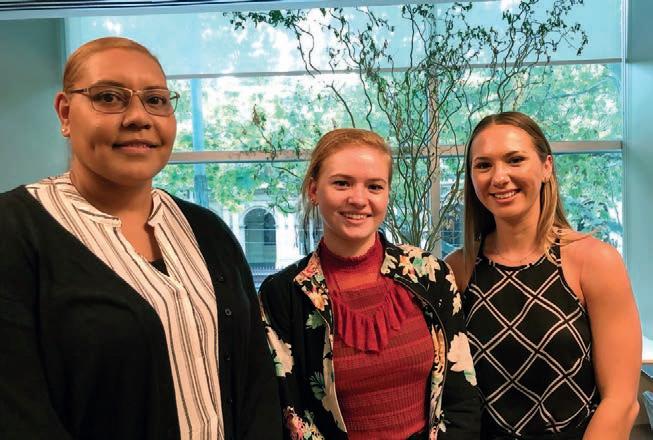
L-R: Kay Johnson, Kassie McAlear, Lucy Denniss-Arnold
› Hosting of a function for the Indigenous Law Students & Lawyers Association of Victoria – Tarwirri—to celebrate the appointment of Magistrate Abigail Burchill as only the second Indigenous Magistrate in Victoria.
› Facilitating a visit to Government House at the invitation of the Hon. Tony Howard QC, for Indigenous law students and lawyers together with members of the IJC.
› Promotion of understanding of Aboriginal and Torres Strait Islander cultural issues within the readers groups.
The work of encouraging and supporting Indigenous law students with the Clerkship Program in conjunction with the Supreme and Federal Courts continues with four excellent clerks participating in 2018. Indigenous law students have also actively engaged in the mentoring program where they are assigned both a judicial and barrister mentor.
IJC members have also represented the Bar at the opening of the Koori Court at Shepparton and at events in NAIDOC Week and National Reconciliation Week.
The IJC supports the policy work of the Law Council of Australia with respect to legal issues involving Indigenous Australians.
The Committee sincerely thanks those who retired November 2017, Michelle Quigley QC, Michael Wise, Anna Robertson, Anne Hassan, Amy Brennan, Premala Thiagarajan, and Astrid Harben-Beer and to Katharine Gladman who retired June 2018.
We also thank Rachel Chrapot and Travis McKay from the Bar office for their enormous support of the work of the committee.
The year has focused on broadening the work of the committee to areas of equality and diversity beyond gender. To that end the committee has established a working group to address issues relevant to LGBTI members. It has also established a working group to address cultural and linguistic diversity at the Bar. The working groups are developing resources and events to
support members, to highlight ways of reducing discrimination that occurs within the legal community and to promote and celebrate the growing diversity of the membership of the Bar.
The committee has supported the work of the Bar Council with CPD support for the introduction of the Bar’s new conduct policies and procedures for dealing with discrimination, bullying and sexual harassment.
The committee has built on the strong work of previous years implementing the Gender Equitable Briefing Policy with continuing promotion and education leading to 168 barristers, clerks and five individual barristers now formally adopting the policy.
The Committee thanks the following members who retired during the year: at 31 December 2017: Susan Borg, Michael Stanton, Evelyn Tadros, Lesley Taylor QC, Christopher Tran; at 31 May 2018: Angie Wong (Secretary).
We congratulate on their appointments, Committee members Hon Justice Lesley Taylor; Her Honour Magistrate Michelle Mykytowycz; Angie Wong (Public Defender); and Hon Justice Michelle Quigley, who as member of the Bar Council was responsible for liaison between the Council and the Committee.
The success and productivity of any Committee of the Bar is determined first and foremost by the willingness of practitioners to volunteer for appointment and to apply their energy and talents to projects or matters at hand. The Human Rights Committee has been blessed by dedicated members who have contributed significantly to the Committee’s work. We thank them for their service.
The Committee’s task is to raise for attention issues that affect the liberty and dignity of all persons where those issues engage human rights. The Committee is especially concerned with issues affecting access to justice, equality before the law, freedom from discrimination and from the arbitrary exercise of power, and adherence by Government at all levels to widely accepted human rights norms, including those established by the International Conventions to which Australia is a signatory.
The Committee’s focus is on legislation and policy, and other issues which raise systemic issues, within Victorian and Commonwealth jurisdictions. It does not address individual cases.
The Committee met regularly during the year under review, at approximately six-weekly intervals during legal term, as well as conducting business by sub-committee and by circular email when issues required urgent attention.
Throughout the year, the Committee reviewed federal and Victorian proposed legislation and considered relevant parliamentary inquiries. Consistently with the themes of recent years, the Committee reviewed the human rights issues raised by Bills or policies concerning access to justice and legal aid; respect for the independence of the Courts and tribunals; police powers and accountability; sentencing and parole; counterterrorism; freedom of speech, freedom from discrimination and freedom of religion and the treatment of asylum seekers.
Additional major work undertaken by the Committee in the past year included:
› Sexual harassment and discrimination. Following the release in August 2017 of a very substantial report by the Australian Human Rights Commission entitled Change The Course: National Report on Sexual Assault and Sexual Harassment at Australian Universities (2017) the Committee considered that it raised important issues for all institutions, including the Bar, to consider.
› Accordingly, prompted by the report, the Committee requested the Bar Council to review, and if required update and, in any case, widely publicise, the Bar’s policies and protocols for reporting, addressing and preventing incidents of sexual harassment or violence by or against barristers and their staff and by or against instructors and clients when dealing with members of the Bar.
› The Committee renewed this call in 2018 and was especially supportive of the recommendations of the Working Group convened by the President and chaired by Jacinta Forbes QC, and by the policies adopted by the Bar Council, as reported elsewhere in this report.
› The Committee supported and assisted interventions of members of the Bar at the Magistrates’ Court of Victoria, which reversed the levying of charges on parties to proceedings seeking access to a copy of Court orders affecting them.
› The Committee supported the public statements of the President of the Bar Council in support of the independence and integrity of Victorian judges, in the face of political mischaracterisation of sentencing decisions of the Courts.
› The Committee supported the principles developed by the Law Council of Australia on issues concerning the constitutional recognition of Aboriginal and Torres Strait Islander peoples, and the Law Council’s submissions to Federal Parliamentary Joint Select Committee inquiry on that topic. These were to the effect that:
› the Australian Constitution should formally recognise the distinct identities of Aboriginal and Torres Strait Islander Peoples, and secure to them equality before the law;
› the Law Council urged support for the full implementation of the 2017 recommendations of the Referendum Council including the Uluru Statement from the Heart
› the Law Council supported the application of relevant
international human rights law, including the United Nations Declaration on the Rights of Indigenous Peoples; and
› it was important to continue to consult with Aboriginal and Torres Strait Islander communities and organisations in considering options for Constitutional reform.
› The Committee discussed and planned the holding of Professional Development seminars on a number of human rights topics. After canvassing a variety of possible topics and presenters, the Committee organised a practice refresher on refugee application cases (in conjunction with the Migration Law Bar Association) and seminar on police accountability. These seminars are to be conducted in the coming year.
Other contributions:
› Peter Fox QC and Peter Willis SC continued as member and alternate member, respectively, of the Law Council Working Group on Business and Human Rights. A major focus during the year under review was work on the Modern Slavery Bill 2018 (Cth). The Committee was kept abreast of this work throughout the year.
› In response to a request to the Committee from Deakin University, Anthony Krohn chaired a Global Panel Discussion on ‘Human rights, global business and developing economies’ as part of a Professional Development Workshop with the Sri Lankan Attorney-General’s Department held at the University.
Once again, the Committee has worked collaboratively with other interested organs of the Bar, including the Equality and Diversity Committee; Indigenous Justice Committee; and the Criminal Bar Association and Migration Law Bar Association. We acknowledge with thanks the assistance during the year under review of the Bar’s policy lawyers, Emma Fox and Travis McKay.
Pro Bono is a longstanding tradition of the Victorian Bar. The Bar has established a number of schemes to facilitate access to pro bono legal assistance from barristers.
The broad “Victorian Bar Pro Bono Scheme” which receives requests for assistance from the general community is supervised by the Pro Bono Committee and administered by Justice Connect. Pro bono legal assistance provided under this scheme covers a wide range of services: from legal advice, to preparation of Court documents to full representation at hearings in Court. Around 1200 members of the Bar have volunteered to participate in the scheme. In the year ending 30 June 2018, 639 enquiries were received for pro bono help. 499 eligible cases were placed with pro bono lawyers, with members of the Victorian Bar accepting referrals in 335.
Separately, the Victorian Bar has also established a variety of “Duty Barrister Schemes” with various Victorian Courts under which barristers provide pro bono legal services at the request of the Court.
This year, at the start of 2018 the Bar Council initiated an overall review of the various duty barrister schemes, one of its aims being to improve their operation and efficiency to maximise the impact of pro bono work, establishing a working group of the Bar Council comprising Fiona Ellis (Chair), Erin Hill and Sarah Keating who have worked with the Pro Bono Committee on this task.
Under the auspices of that review, and in conjunction with the Bar Office, we commenced the project of creating more streamlined and transparent processes for placing Court requests for pro bono assistance the from barristers. The project has two phases.
The first phase has been to engage collaboratively with each Court from which a pro bono scheme operates to establish new, clear and consistent, referral processes from each Court. Three key elements were identified as necessary to be in place for the success of a referral scheme:
1. A designated point of contact in the Court for pro bono requests coming out of each Court;
2. An agreed written protocol regarding eligibility for pro bono assistance and about the way the scheme is to operate from each Court;
3. Clear mechanisms for assessing cases for eligibility (triaging) and agreed processes for placing a request through the Bar Office to a relevant pool of volunteer barristers.
It is pleasing to report that the Bar Council gave its approval in August 2018 to the first protocol to be put in place with the County Court, which is to operate out of its Commercial and Common Law Divisions.
The preparation of this document was a collaborative effort involving the whole of the Pro Bono Committee, the members of the Bar Council’s working group, the Bar Office and representatives from the County Court. Particular acknowledgement must be given to Meredith Schilling and Michael Rivette and Claire Harris QC, who were all involved in our discussions with the County Court about the protocol, and in its drafting and refinement. The support and guidance of the Bar’s CEO, Sarah Fregon is also thankfully acknowledged. Special acknowledgement, and personal thanks, must also be extended to Judges Woodward, Saccardo and Cosgrave, Judicial Registrars Tran and Burchell and the County Court’s self-represented litigant (SRL) case managers Nicole Maher and Candice Jackson for their time and deliberation on the document, and for the cooperative and collaborative spirit that underpinned our discussions in designing this new iteration of the pro bono referral scheme in the County Court.
The new protocol is designed to promote the fair administration and integrity of the scheme, facilitate referrals and harness the goodwill and capacity of barristers to undertake pro bono work in the Court. Its beneficiaries will be the self-represented litigants who receive pro bono help, as well as the Court itself, the Bar and barristers who volunteer their time and services. It is purpose is to advance the public interest in both the due administration of justice and access to justice - pro bono publico It contains agreed eligibility criteria and mechanisms for referral by Court “order” (consistent with Federal Court Rule 4.12). It contains guidance for the Court about defining the “referral brief” as well as about the sorts of cases that (in practical terms) can be undertaken on a pro bono basis, all designed to help ensure the sustainability, efficient operation and fairness of the scheme. It makes provision for referral requests for an amicus curiae to assist the Court and gives guidance to the barrister’s role when acting as amicus curiae. It identifies the SRL case managers as the point of contact between the barrister and the Court for administrative and procedural matters in the conduct of a referral. It provides for data collection and professional development training, and contains provision for two-way feedback and yearly review of the operation of the scheme, and on areas for improvement.
The next step will be to develop similar, clear and consistent written protocols in collaboration with other Courts that make requests for pro bono assistance to the Bar. Initial discussions have taken place during the year with representatives from the Supreme Court, Court of Appeal and Coroners Court, as well as with the Magistrates’ Court.
The second phase of the project is the development, also commenced in 2018 by the Bar Office, of a new pro bono “online Portal” which will assist the Bar and the Courts to manage enquiries and requests for assistance in an efficient, accurate and timely manner through the use of technology. The Committee will continue to provide input into its design. One of its aims is to harness the capacity of pro bono at the Bar, by increasing barrister participation rates in pro bono schemes and improving rates of acceptance of pro bono requests from Courts.
In 2018 the Committee established new sub-committees for each existing and new pro bono scheme.
The Committee also presented at a number of CPD seminars:
› In November 2017 we conducted a seminar on the topic of pro bono costs recovery, delivered by Richard Wilson, Stephen Warne and Evelyn Tadros, discussing the new Supreme Court pro bono costs rule contained in Part 3A, Order 63.34 of the Supreme Court Rules and the drafting of pro bono costs agreements.
› In February 2018, David Yarrow delivered a talk about pro bono at the Bar at a CommBar seminar on self-represented litigants in commercial litigation, presented by Judge Woodward and other CommBar members.
› Committee members also continue to present two sessions a year (October and May) to the Bar Readers Course about pro bono at the Bar.
In March 2018 the Attorney-General announced the Victorian government’s response to the independent review of the Open Courts Act 2013 (conducted by former Supreme Court of Appeal Justice Frank Vincent) to which the Committee had made submissions. The Victorian government supported in full or in-principle 17 of 18 recommendations (keeping under consideration the remaining recommandation).
To help barristers to volunteer under the various schemes, a new combined “Expression of Interest to participate in pro bono schemes” form was developed to replace the various forms previously in use for different schemes. Meg O’Sullivan and Alan Yang (from Justice Connect) who prepared it ahead of our presentation to the Bar Readers in May this year are to be thanked for their work on this. The new combined form is structured to show the interrelationship between the Victorian Bar Pro Bono Scheme and the various Court-Based Pro Bono Schemes operating across Federal and State jurisdictions and to give better visibility to the different pro bono referral pathways to the Bar.
Again this year it has been very pleasing to receive thanks and letters from members of the profession and judiciary expressing gratitude to specific members of the Bar who have provided their pro bono assistance in cases before the Courts.
The EPD Executive (EPDE) comprises the Chair and Deputy Chair of each of the CPD Committee, the Bar Readers’ Course Committee and the International Advocacy Committee. The EPDE enables discussion across these committees particularly on issues which are relevant to more than one of the committees.
The EPDE Chair holds an ex-officio position on the Indictable Crime Certificate Committee to advise that committee on relevant education issues as the need arises.
The EPDE is supported by the Bar office and particularly by Rachel Chrapot (General Manager, Member Services). The ongoing role of this committee is to be reviewed over the next 12 months.
The Continuing Professional Development Committee with the assistance of the Bar Office, has continued to exercise its delegated powers of dealing with the day-to-day management of the CPD program and the requirements of barristers to undertake the requisite CPD activities during the year. That has included determining requests for accreditation of CPD activities, dispensing with the requirements of the program in respect of certain barristers, overseeing the audit of compliance with CPD requirements and dealing generally with issues raised relevant to the program.
The CPD program continues to provide seminars of high standard to members in all of the categories of CPD. Included in the program have been workshops in jury skills, cross examinations and ethics which were all popular and well received. In June 2018, together with the New Barristers’ Committee, the CPD Committee organised the Junior Bar conference. The conference was well received and will be a permanent fixture on the Bar’s CPD calendar.
In addition, with the assistance of the Bar office staff, the committee supervises the administration of the annual CPD audit. A random selection of 5% of the Victorian Bar members is selected to monitor that members are complying with their CPD obligations. Those who have disclosed that they have not complied with their CPD obligations at the time of renewing their practising certificates are also included in this audit process.
The CPD Committee also undertook a review of the CPD resources and layout on the Victorian Bar website and prepared a report which concluded that the website resources were of a high standard and working well, whilst also identifying some areas for further refinement.
The CPD Committee continues to be involved with the implementation of the CPD rules and will be monitoring and providing input into the development of policies that will inform the operation of these rules.
During the last year the Committee has continued to oversee the form and content of the Readers Course and the Bar Exam in close consultation with the General Manager, Member Services, Rachel Chrapot and with the Course Coordinator, Wendy Pollock. After the March 2018 Course, a review of course content was undertaken by the Chair, assisted by the Course Coordinator, to secure improvements in delivery of course content and performance.
The conduct of the entrance exam continues to represent a significant piece of work by the members of a separately
constituted working group. The committee continues to be involved with curriculum development for the Course with input and support from the Bar Office.
In May 2018, the Committee formed two working groups to undertake special projects. The first was set up to devise terms of reference for a review of the Bar exam, whose review is to take place in the coming months. The second working group was set up to scope an international internship program for overseas applicants who may wish to apply to participate in a four to five weeks familiarisation program with the Victorian legal system. The idea would be to provide guidance to lawyers from countries with developing legal systems who could benefit from exposure to a successful common law system. These projects are both under way and reports will come back to the Course Committee in the next couple of months.
The Readers Course continues to attract wide interest as more practitioners decide to come to the Bar. 105 candidates sat the November 2017 exam and 41 received offers of a place in the course. With deferrals places from the previous exam included, there were 45 readers in the March 2018 course. In the May 2018 exam there were 118 candidates, with 43 candidates receiving offers. The September Readers’ Course will commence on 30 August 2018 with 43 readers plus one overseas reader from Malaysia.
The Committee remains grateful to the Bar office, particularly to Rachel Chrapot and Wendy Pollock for their ongoing assistance over the last 12 months.
Since 1990 members of the Victorian Bar and Judiciary have provided advocacy skills training to trainees of the Legal Training Institute, Port Moresby, Papua New Guinea and to lawyers of the South Pacific Region generally. The Committee continues with these activities.
In July 2017 the 17th Civil & Criminal Advocacy Workshop was conducted in Port Moresby for the Legal Training Institute over of 5 days of intense teaching and coaching. A total of 90 trainees attended the workshop. These advocacy skills workshops have become an integral and compulsory part of the course undertaken by graduates as part of their qualification for admission to practice as national lawyers in PNG. The workshop was led by Philip Corbett QC and her Honour Justice Elizabeth Hollingworth of the Supreme Court of Victoria. The teaching team was Benjamin Lindner, Maya Rozner, Trevor Wallwork, Paul Kounnas, Emma Peppler, Diana Price, Shivani Pillai, Daniel Nguyen and Wendy Pollock (as administrative assistant). The Director and the staff of the Legal Training Institute consider the workshop to have been extremely successful. Funding for the workshop is provided by the Australian Government Department of Foreign Affairs and Trade.
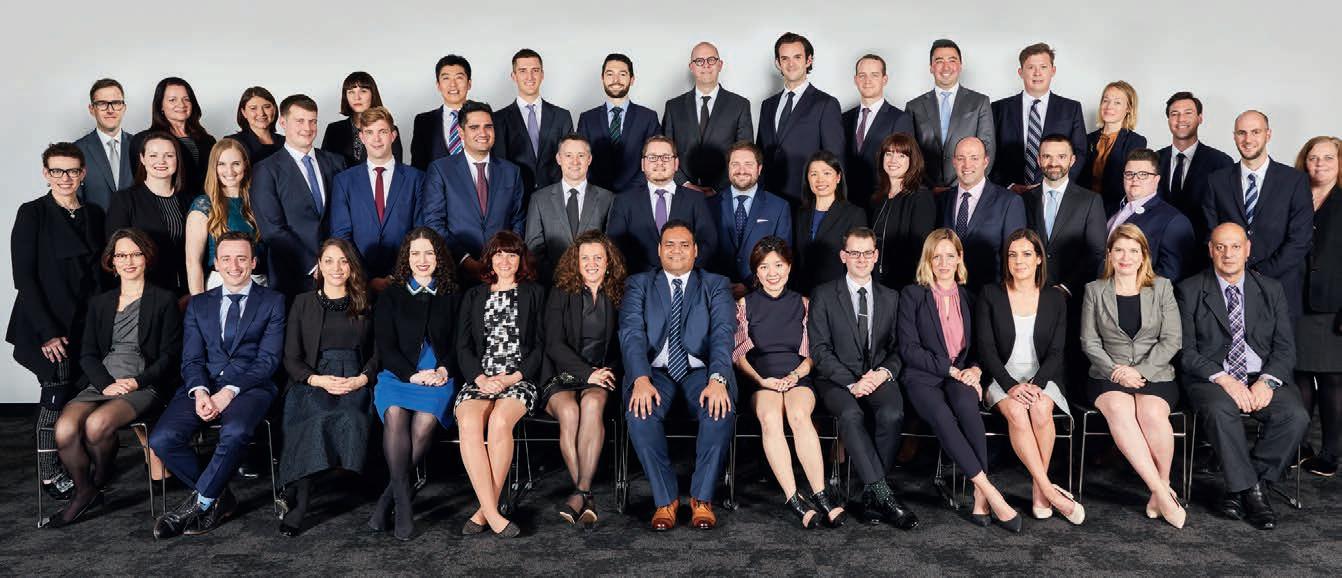
THE VICTORIAN BAR – SEPTEMBER 2017 READERS: Back row: Lindsay Hogan, Maria Tenace, Roxanne Burd, Katarina Ljubicic, Matthew Meng, William Newland, Grant Lubofsky, Willem Drent, Samuel Burt, Albert Ounapuu, Joe Connolly, Zac de Kievit, Sandra Wendlandt, Oliver Lesage Middle Row: Rachel Chrapot, Laura Hilly, Caitlin Dwyer, Timothy Farhall, Simon Fuller, Tristan Nathanielsz, James Strong, Christopher Edwards, Patrick Gordon, Xuelin Teo, Felicity Blair, Daniel Preston, Ivan Hristovski, Ffyona Livingstone Clark, Mathew Kenneally, Wendy Pollock
Seated: Katrina Chow, Harry Lewis, Rachel Matson, Jane Gregory, Karen Chibert, Juliette Buxton, Tauvasa Tanuvasa Chou-Lee, Mable Leong, Adam Maloney, Lucinda Thies, Jessica Willard, Marion Isobel, Nicholas Doukas.
The Empowering Women in Law in PNG program for the female students of the Legal Training Institute (LTI) was delivered for the third time in 2017 in partnership with the LTI and with the support of the Australian Government – Justice Services and Stability for Development (JSS4D). The aim of the program is to build confidence in and empower women entering the legal profession in PNG by engaging women on critical issues affecting their advancement within the profession. A new program for male students was also held at the same time with sessions on mentoring, health and wellbeing, respect in the workplace and improving legal research skills.
Once again, the Victorian Bar was invited to present a weeklong training series for government lawyers and prosecutors in the Solomon Islands an entirely new program was developed including, written advocacy, civil and criminal appellate advocacy, ethics, civil and criminal procedure. The teaching team comprised His Honour Judge O’Neill from the County Court, Maya Rozner, Trevor Wallwork, Nicholas Goodenough, Steven Russell and Wendy Pollock (administrative support).
A teaching team also delivered a criminal advocacy workshop for prosecutors and public defenders in Vanuatu.
Invitations have been extended to the Victorian Bar to deliver advocacy training in several other South Pacific nations in 2018 and beyond.
The Committee also co-ordinates the selection and placement of international students in the Bar Readers Course, demand for places in the course for lawyers from the South Pacific has increased and is highly sought after by emerging leaders of the profession in the region.
The Committee is continually arranging further advocacy skills workshops to meet the needs particularly of the lawyers of the South Pacific with whom the Committee and teaching teams have formed close bonds. The Victorian Bar has developed and retains a strong reputation for the delivery of pro bono advocacy training in the South Pacific and 2017-2018 saw that reputation continue. The members of all teaching teams and committee work hard and under difficult conditions and their work and dedication reinforces the commitment of the Victorian Bar to legal education and advocacy training.
The committee acknowledges the ongoing support of the Bar office during the year, particularly Wendy Pollock, Readers’ Course Co-ordinator.
The Committee thanks Caroline Paterson, who retired during the year.
The Student Engagement Committee (SEC) was formed in 2010 with the objective of ‘demystifying’ the Bar by providing high school and tertiary students with a better understanding of the work of the Bar, and of the pathways to becoming a barrister. During 2017-2018, the Student Engagement Committee met monthly and was actively involved in a number of initiatives to engage high school and university students from all institutions across Victoria with the Bar.
In pursuing its aims, the Student Engagement Committee is primarily engaged in:
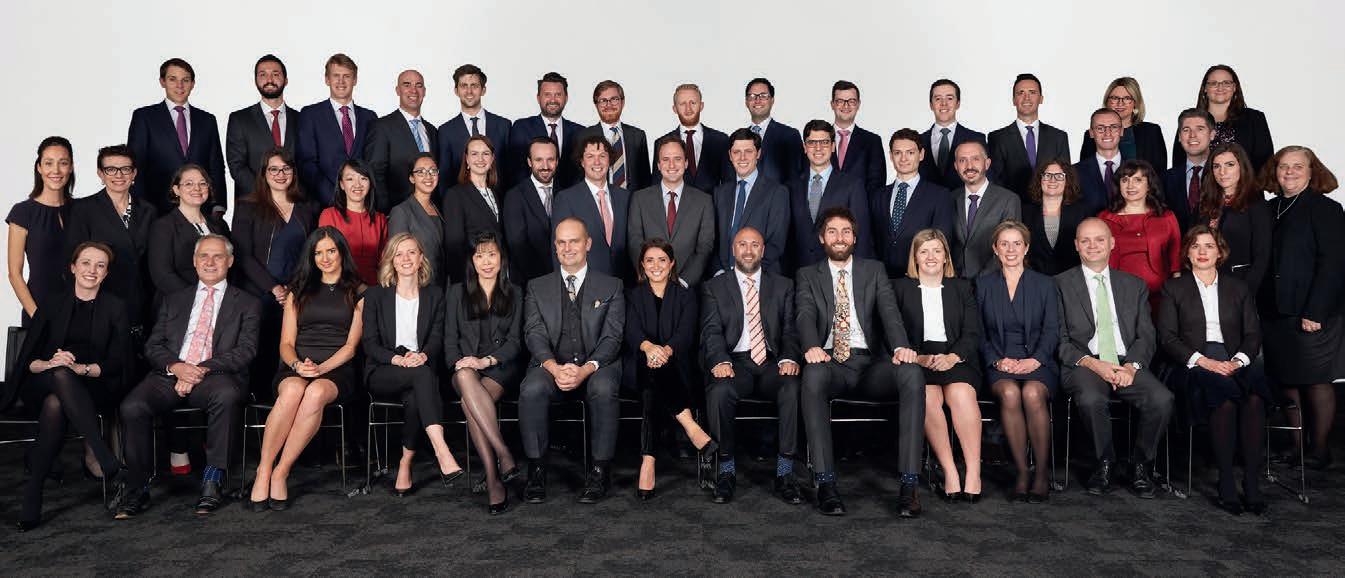
THE VICTORIAN BAR – MARCH 2018 READERS: Back row: Geoff Lake, James Portelli, Jonathan McCoy, Ramon Fowler, Nick Modrzewski, Stephen Scully, Andrew White, William Barker, Bill Stephenson, Callum Dawlings, Andrew Roe, Glenn Barr, Kate Ballard, Joanna Dodd Middle Row: Rachel Chrapot, Amanda Carruthers, Caroline Dawes, Julia Zhou, Abilene Singh, Simone Tatas, James Claridge, Matthew Tennant, James Stoller, Paul Reynolds, Nicholas Walter, Lachlan Molesworth, George Glezakos, Sally Bastick, Lachlan Carter, Maryanne Gassert, Mitchell Grady, Nonni Sdraulig, Wendy Pollock Seated: Alexandra Metherell, Tim Smurthwaite, Edwina Keynes, Tanya Skvortsova, Pauline Chia, Simon Kelly, Veronika Drago, Amit Malik, Hugo Moodie, Amy Hando, Joanne Poole, Ben Hill, Serena Armstrong.
› placing high school students in its Work Experience Program and University students in its Shadowing Program;
› engaging with and presenting to high schools and universities; and
› raising the profile of the Bar to students through events, information and communications.
In 2017-2018, the Committee underwent a number of structural changes to streamline its operations, including reducing the number of sub-committees (Law Week, Communications) and trialling a number of new initiatives. These included running the Work Experience Program at scheduled times to increase the number of participants, increase efficiency and reach a ‘critical mass’ whereby group activities can be run for the participants, such as Court tours. In addition, the Committee has produced a raft of new information and promotional material, including an updated information for university students booklet, flyers for High Schools, the promotion of Law Week and the VicBar Open Day and further updates to the SEC internal and external webpages and Facebook page.
The demand from university and high school students for work experience and shadowing opportunities with the Bar is high and ever increasing.
The SEC makes a distinction between the Work Experience Program offered to High School students (in accordance with the Department of Training and Education requirements) and the Shadowing Program available to University students. The Shadowing program replaces the former Mentoring program, in
an effort to avoid duplicating mentoring programs run by University organisations.
During 2017-2018, the SEC has arranged 136 shadowing and mentoring opportunities for high school and university students. The feedback received by the SEC about these work experience placements was excellent and highlights how valuable these opportunities are to students, and in promoting the Bar as an excellent career.
The SEC is grateful to the members of the Bar who continue to volunteer their time to attend school speaking engagements, act as mentors to students and afford work experience opportunities to students. The SEC is always keen to hear from barristers who would like to participate in its program. If you have such an interest or would like to know more, please email students@vicbar.com.au.
The SEC would like to thank the Student Matching Coordinators, Charlene Mangion and Arianne Daly, for their invaluable assistance in keeping the SEC work experience and shadowing program running efficiently during the 2017-2018 year.
The SEC conducts a number of presentations to educational institutions and arranges for barristers to attend events in order to inspire the Counsel of tomorrow. This year barristers presented to University High School, Parkville (thanks Sebastien Reid), La Trobe University Careers Fair (thanks to Erin Hill, Gerard O’Shea, Andrew Kirby), ACU Law Careers Fair (thanks to Gerard O’Shea, Caroline Paterson, James Waters), Monivae
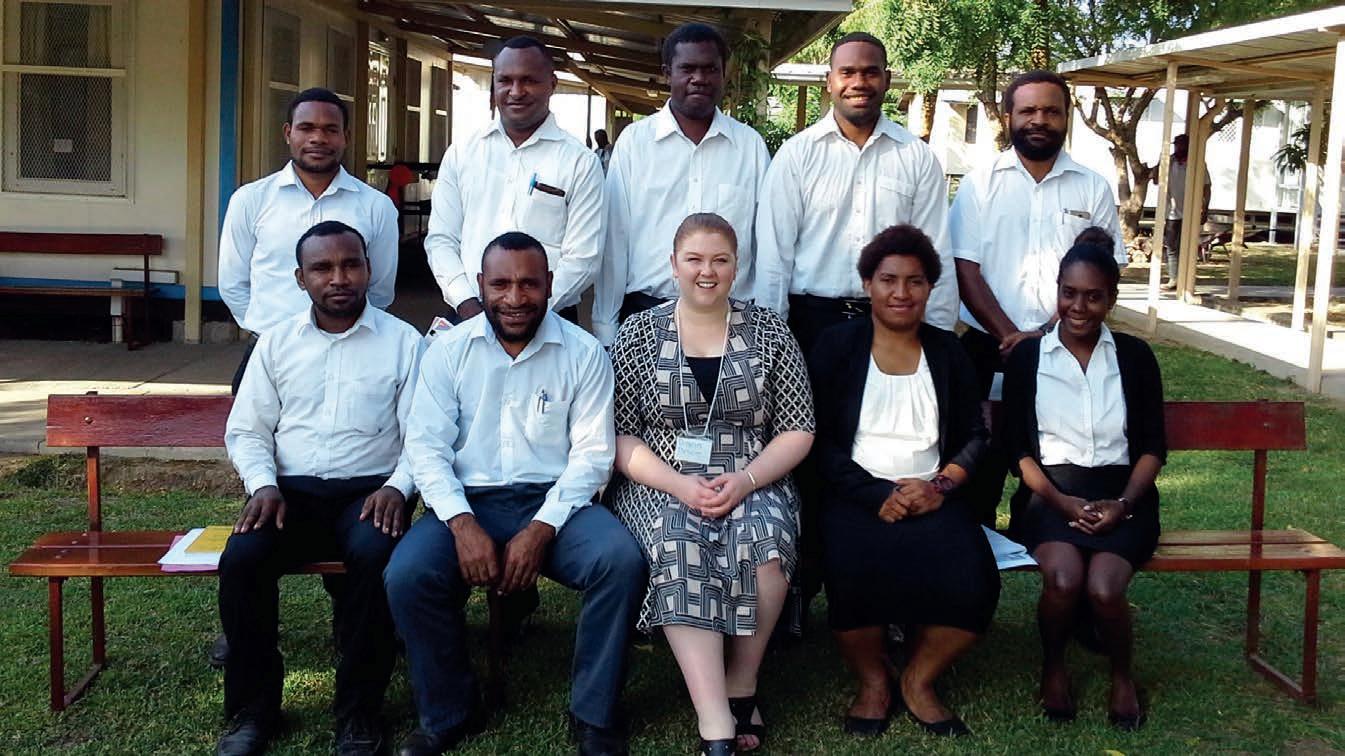
College, Hamilton (thanks to Tony Thomas), Bayside College, Newport (thanks to Gerard O’Shea and Garry Fitzgerald QC), University of Melbourne Law School (thanks to Amanda Burnnard), Wyndham Secondary College (thanks to Gerard O’Shea), Monash Law School Beyond Commercial Careers Fair (thanks to Shaun Ginsbourg) and the Yarra Careers Group (thanks to Andrew Kirby, James Waters).
The student response to our attendance was very positive at these events. Visits are an important part of the work of the SEC and have an important function in demystifying the role of the barrister in the justice system, as well as explaining pathways to the Bar.
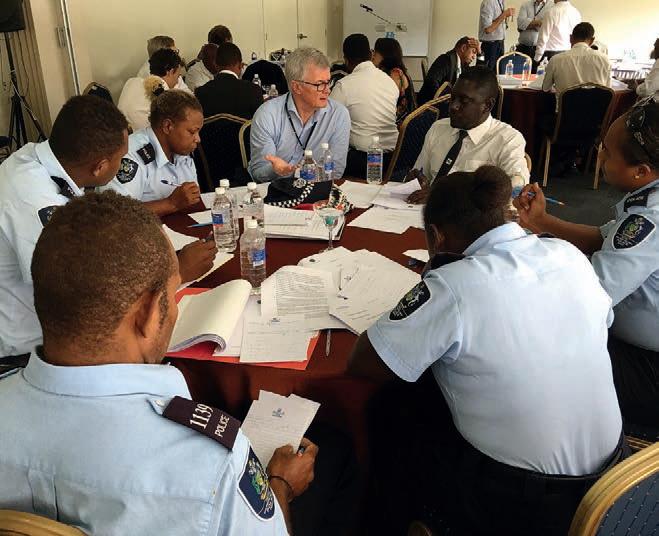
The SEC was involved in a number of exciting events that promoted the profile of the Bar to students, including the County Court Open Day (the performance of Bailed Out –the Role of a Barrister was a huge success, thanks to Shaun Ginsbourg, Amanda Burnnard, Erin Hill, Sebastien Reid, Penny Marcou) during Law Week and the inaugural VicBar Open Day. The VicBar Open Day was immensely successful with around 100 students attending (many thanks to Dr Matt Collins QC, Rachel Chrapot and all who were involved).
The Committee thanks the members who retired during the year, namely Gerard Dalton QC, Mark Costello, Nawaar Hassan, Sarah Varney, Raph Ajzensztat and Andrew Bell.
This year the Victorian Bar joined the Law Library of Victoria (LLV). We are the first professional Association to do so and there are numerous benefits, including a dramatically increased online collection and the assistance of professional librarians. Ms Belinda Schembri of the LLV attends on Tuesday and Thursday afternoons, providing direct assistance to barristers accessing and exploiting the vast new online resources. These include Lexis Advance, as well as other Lexis Nexis AU titles, CCH Intelliconnect, Timebase and many international resources, including ICLR, Hein Online, Westlaw UK and Westlaw Next. This is a vast expansion of our online holdings, which were previously limited to the Lexis Nexis VicBar titles and CCH Intelliconnect.
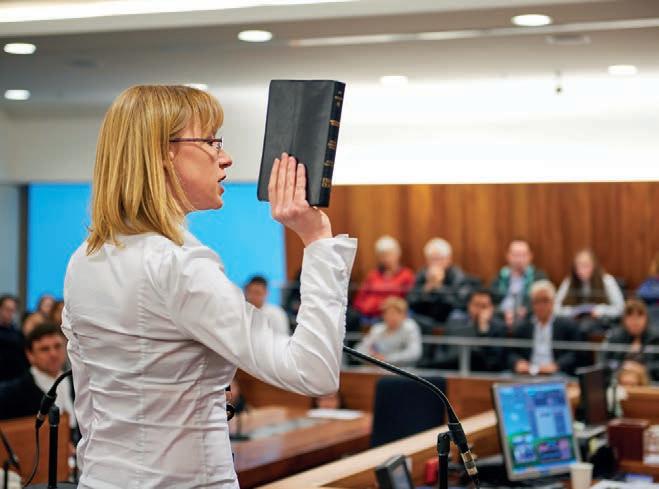
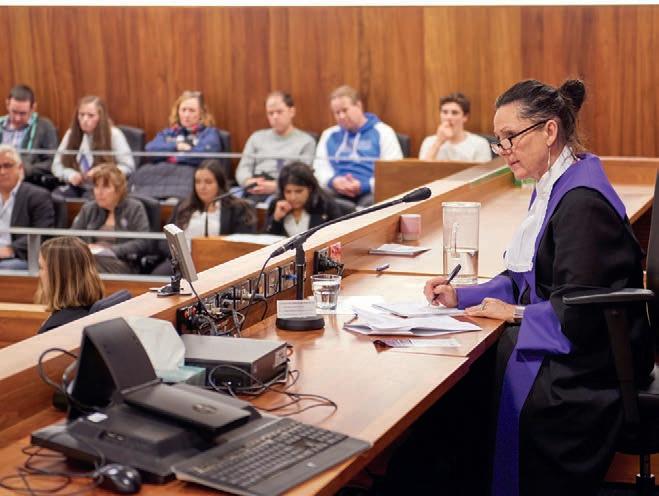
The Committee is very grateful to all the long support over many years from our previous online publishers, Lexis Nexis and CCH. Particular thanks go to CCH’s Annie Hutchinson who attended every Wednesday over several years to support barristers using the CCH online package. The Bar Office staff continue to provide tireless administrative support and assistance to the library committee and users.
The large sliding door between the Richard Griffith Library room on the First Floor of Owen Dixon Chambers East and the Essoign Club is now open every morning and you’re welcome to bring in your morning tea or coffee to our coffee tables and enjoy the monograph or historical collection. This room houses the new online resources, new photocopier, lots of new textbooks acquired in the EOFY sales, as well as Australian authorised reports, text books and heritage items. English reports and most journals are in the Neil McPhee Room next door. Other international reports and journals are located in the Bar Council Chamber. Branch libraries for spare sets and some donated collections have been established in Owen Dixon Chambers East and West, Bourke Chambers, Crockett Chambers and Castan Chambers in various common areas. See the Directory in the Richard Griffiths Library room for details. The library web page is being updated to include the new online resources and a searchable catalogue. The website lists the Library’s hard copy holdings, Policies and procedures, as well as the library committee members, who welcome your questions and suggestions.
The Chair of the Committee addressed the March and September Readers Courses and conducted tours of the library.
Members of the Bench and Bar continue to donate books and other items to the Library. In particular the Committee thanks the Honourable Justice Santamaria and Prof Philip Hamilton for their generous donations in the last year.
The Indictable Crime Certificate (“ICC”) is an accreditation and quality assurance program, administered by the Indictable Crime Certificate Committee (“the Committee”) on behalf of the Victorian Bar. The Committee supports the development of quality and competence in this challenging jurisdiction and offers a clearer path to those aspiring to run trials.
In 2017/18 the Committee received nine applications, taking the total number of received applications to 314. A total of 228 certificates have been granted – Stream A: 46 Stream B: 171 and Stream C: 11 certificates granted.
The Committee thanks the Hon. Stephen Charles AO QC, the Hon. Mandy Fox QC and the Hon. Lesley Taylor QC and the Hon. Michael Cahill SC, who retired during the year.
The Hon. Robert Redlich QC will take the role as chair of the committee from 1 July 2018.
The committee would also like to acknowledge the contributions of the Hon. David Habersberger QC and Justin Hannebery, who have both provided invaluable support to the committee.
Thanks also to Rachel Chrapot and Jayne Sandri from the Victorian Bar office for their continued support of this program.
Promotion of VicBar Accredited Mediators: The Committee has continued its work to bring to the attention of the courts and professional associations the benefits of using Vicbar accredited mediators. Based on a protocol developed between the Committee and the Federal Circuit Court, the Court has implemented a pilot project to refer Intellectual Property disputes for mediation by the Bar’s nominee. With some further refinements it is hoped this protocol will become the basis for all requests received by the Bar President for nominations of a mediator. Productive engagement with the CPA continues and a similar approach to the CAA is under consideration. Updating the accuracy of the Magistrate’s Court SLEM list has also been achieved.
Lawyer’s Certificate in Mediation Course: Another successful Lawyer’s Mediation Certificate Course was held in June 2018 in the Bar’s newly renovated first floor premises. Eighteen participants [of whom 15 were barristers, one a court official and two solicitors] attended the course. These participants rated the course very highly. The course leaders were again Dr Peter Condliffe, Dr Elizabeth Brophy and Tony Neal QC. The Mediation Course is a premier course and the Mediation Course Sub-Committee is to be congratulated on the continued success of it.
CPD Sub-Committee: The CPD Sub-Committee under Carolyn Sparke QC, as well as conducting seminars, has continued with monthly workshops for mediators to debrief, discuss current issues and recent authorities. The Committee’s view is that such sessions qualify for NMAS re-accreditation purposes.
ICC Asia Pacific Mediation Competition: The Competition took place in July 2017. Committee members Marianne Barker and Michael Heaton QC liaised with the ICC in relation to this event and organised a prize to be awarded in honour of the late Henry Jolson QC.
Family Law Sub-Committee: This Sub-Committee is closely monitoring developments in the family law space particularly stemming from the proposed merger of the Federal Circuit and Family Courts. The use of arbitration in family matters is a matter of particular interest.
Acknowledgments: The ADR Committee thanks Ross Nankivell, Manager Ceremonies & Protocol, for his attendance, input and assistance and the Bar Office for its administrative assistance with the running of the LMC course.
The committee’s primary work this year has been to formulate a plan for chambers in Singapore which is workable and will attract necessary support from interested counsel and key stakeholders such as the Bar Council. It is very pleasing to report that on 26 July 2018 the Bar Council resolved to endorse this initiative. More than 15 counsel have so far stated their commitment to participation. The Committee hopes lease negotiations will conclude quickly so that a hard launch can coincide with the ABA’s 2019 conference.
The Committee thanks Chris Winneke QC for his work on the Committee, particularly in the position of Chair for 2016 –2017. The Committee welcomed new members Jacinta Forbes QC and Fiona Ellis and welcomed Rachel Chrapot, General Manager Member Services and Jayne Sandri, In-house Lawyer Governance and Compliance.
The Counsel Committee is appointed pursuant to clause 63 of the Constitution of the Victorian Bar Inc. It is composed solely of members of the Bar Council and its chair is appointed by Bar Council from time to time. The role of the Counsel Committee is to consider, and make recommendations to the Bar Council in relation to the grant, renewal, variation, suspension and cancellation of practicing certificates, applications to sign the Roll of Counsel and the removal of names from the Roll (pursuant to Part 14 of the Constitution).
The Committee is only required to meet on an ad hoc basis and since the last report has met four times for general matters, had one special purpose meeting and held one formal hearing.
The Bar’s Protocol for Dealing with Disclosures delegates to the honorary secretary the role of reviewing routine disclosures made in the course of applications for renewal or grant of practicing certificates, and applications to sign the Roll of Counsel, and to make recommendations directly to the Bar Council.
The 2017 – 2018 Practicing Certificate renewal period required the review of 13 disclosures for recommendation to the Bar Council. Pursuant to the protocol described above, the Honorary Secretary reviewed and made recommendations on a further 20 matters.
The Committee has considered two matters in which there were disclosures of show cause events pursuant to s.88 of the Legal Profession Uniform Law. At 30 June 2018, one of those matters had been finalised and one is the subject of continuing investigation. In addition, the Committee finalised seven other matters and has considered one matter concerning practitioner suitability and as at 30 June 2018, one matter was the subject of continuing investigations.
The Committee would like to thank Jayne Sandri for the tremendous support and assistance that she has provided in her role of In-house Lawyer, Governance and Compliance. The Committee wishes her well in her future endeavours. The Committee welcomes Travis McKay, policy lawyer, who assumed the role of In-house Lawyer Governance and Compliance on Jayne’s departure.
The Committee was slowly depleted throughout the year by the numerous appointments to judicial office from the ranks. Warmest congratulations are extended to former Deputy Chair of the Committee, Kevin Lyons QC on his appointment as a judge of the Supreme Court of Victoria. Justice Lyons was appointed to the Ethics Committee in January 2009 and was appointed Deputy Chair in May 2017. The Committee thanks His Honour for his long service and outstanding contribution to the Committee and the Victorian Bar over nine years.
The Committee congratulates Justice Lesley Taylor QC and Judge Amanda Fox QC on their respective appointments to the Supreme and County Courts of Victoria and thanks them for their valuable contribution to the work of the Committee.
Melissa Mahady is congratulated on her appointment as a Crown Prosecutor. Melissa has continued to serve on the Committee, recusing herself from consideration of all queries and investigations involving criminal matters. Peter Chadwick QC is congratulated on his appointment as Deputy Chair of the Committee in July.
The Committee acknowledges and thanks outgoing members Meredith Schilling and Eliza Holt for their dedication and hard work.
The 2018 financial year involved some difficult investigations and complex issues for the Committee, which met on 15 occasions. The Committee welcomed the new Victorian Legal Services Commissioner, Ms Fiona MacLeay on her appointment to that office in January 2018. During the course of the year, Ms MacLeay met with the Chair and subsequently attended a meeting of the Committee. These meetings provided opportunity for discussion between the Commissioner and the Committee as to how the Committee could best serve the Commissioner, the Bar and perform its duties under the Uniform Law as delegated.
The Committee completed investigations and made recommendations to the Commissioner in eight complaints, two preliminary assessments and four grievances. It was pleasing that the Legal Services Commissioner only delegated to the Committee for investigation (down from nine in the previous year), three preliminary assessments, and five
grievances. In addition to the matters delegated to it, the Committee made 63 Resolutions in response to requests made by members during the 2018 financial year. The provision of Resolutions continues to be the main source of work for the Committee and is a valued resource to members of the Bar. It is estimated that in addition to 63 Resolutions granted, the Committee fielded on average five ethical queries per week from members, not requiring a Resolution.
The Committee continued to play an important role in the Readers’ Courses offered throughout the year. The Committee presented two sessions to each Readers Group, including a practical two-hour session where Readers are presented with real complaint scenarios and are required to resolve the issues and make recommendations as if they were a member of the Committee.
In March, the Chair presented a CPD, Current Issues in Ethics and Andrew Strum QC co-presented a CPD Ethics Update for Family Lawyers, organised by the Family Law Bar Association.
The Committee published one Ethics Bulletin this year, which addressed the issue of court transcript providers requesting counsel to sign documentation for the provision of court transcript. Unless specifically authorised to do so, Counsel should not sign such documentation.
Each member of the Committee has spent numerous hours answering telephone calls and emails from members seeking ethical guidance, reading voluminous materials, and preparing reports and correspondence. Thank you to all Committee members for their hard work and commitment to both the Committee and to the members of the Bar.
The Committee is grateful for the continued support and assistance provided by the Victorian Bar Office, in particular Rachel Chrapot, Jayne Sandri and Marisa Pretotto.
The Committee thanks those members who retired during the year. Robert Hay QC, Doug Shirrefs, Theo Kassimatis, Viola Nadj, Michael Symons and Alison Umbers retired from the Committee in 2017. Robert Hay QC was an active member who had oversight on the co-ordination of the counselling service. Doug Shirrefs was a long-serving member of the Committee and in recent times worked closely with Greg Ahern in implementing and obtaining external funding for the Wellness at the Bar Survey.
The Committee has had an active and productive year. Our major focus has been the Quality of Working Life (or Wellness at the Bar) Survey that was conducted in June 2017 with 40% of the Bar membership responding.
There were a number of other initiatives carried forward from the previous year including various sporting activities, first aid initiatives and the CPD program. There were two “Bring your Kids to Work” days held, with tours of the Supreme Court and afternoon tea in the Essoign Club. Demand exceeded available places for both days and there are plans to hold similar events in 2018.
The Victorian Bar Choir remains well supported by regular participants and there were a number of concerts together with Christmas Carols at the Essoign.
The Committee thanks those members who retired during the year: Nicholas Pane QC, Claire Nicholson, Elle Nikou, Brooke Hutchins and Victoria McLeod.
The Committee developed two CPD session for new barristers based on feedback from surveys. These were: a session on negotiation in August 2017 and a session on court craft in February 2018. The Committee has planned a session on ‘working with instructors’ to take place in August 2018.
The Committee hosted a number of casual networking coffees between junior barristers and Senior Counsel in the latter half of 2017. These involved barristers in the commercial, administrative law and common law areas. These events were well attended and the Committee thanks Senior Counsel involved in the program. The Committee will continue this initiative in the latter half of 2018. The Committee is also extending this initiative to criminal and family law and will also host some informal drinks functions for juniors to meet senior barristers in these areas.
The Committee has continued its focus on creating opportunities for junior barristers to meet solicitors. Networking evenings between junior barristers and Law Institute of Victoria Young Lawyers were held on 4 October 2017 and 18 May 2018. These were fantastic opportunities for junior barristers and solicitors to mingle in an informal setting.
The Committee with the Law Institute of Victoria launched a mentoring program between barristers and junior solicitors. The program launched on 14 May 2018. The Committee matched 20 new barristers as mentors to 20 junior solicitors.
The Committee has been represented nationally at the Australian Young Lawyers Committee of the Law Council of Australia.
The Committee has continued to speak to March and September Readers, fielding questions about what the new barristers can expect in the 1st year of practice.
The Committee is grateful for the on-going support it receives from the judiciary, senior members of the Bar, and the Bar executive including the Education and Policy team.
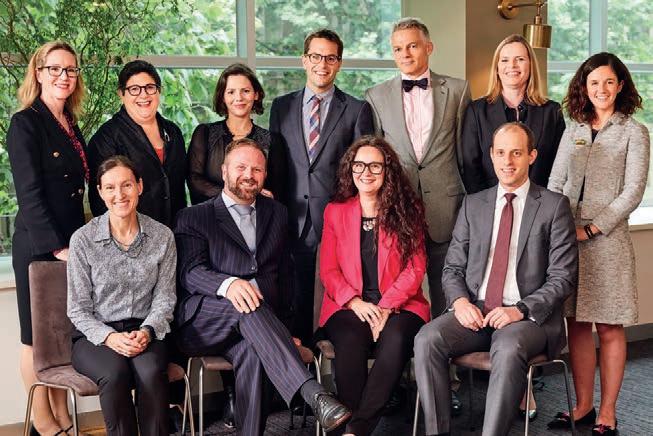
In 2017-2018, the Victorian Bar News committee continued to create a biannual magazine for members of the Bar and Bench. The Summer issue was themed ‘The Travel Issue’, and the winter edition’s leading story was an article by President Maxwell on the rule of law. The purpose of Bar News is to inform readers of various activities around the Bar, to showcase the vast array of talent of its members, and to inspire debate and discussion about matters of interest to barristers and the legal profession.
To be a barrister is to be part of a community. Based on feedback, the Back of the Lift section that covers judicial appointments, farewells and obituaries continues to be one of the most well-read sections of Bar News. With a raft of judicial appointments over the past 12 months, this has been a challenging section to maintain, which led to the appointment of a third editor in March 2018, Annette Charak. Prior to coming to the bar Annette had her own consultancy, training lawyers to improve their written communications. The Bar News Committee is assisted by copy editor Peter Barrett, and Guy Shield, who assists with layout, illustrations, design, typesetting and the look and feel of the magazine. Slattery Media Group is the publisher.
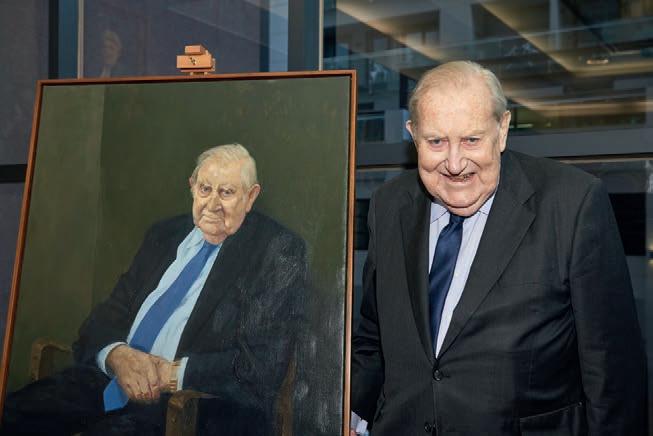
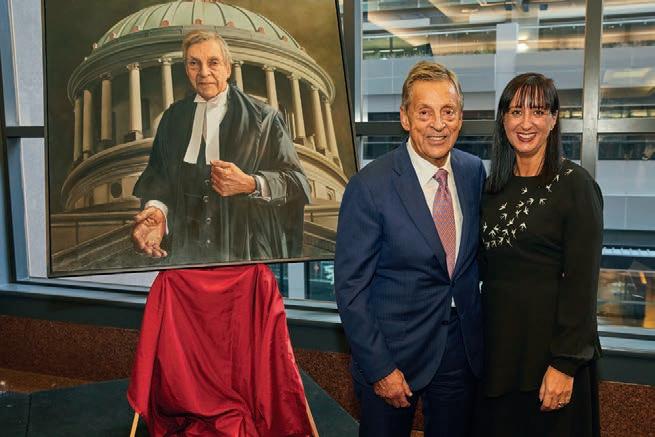
The Peter O’Callaghan QC Gallery in this reporting year unveiled several new portraits and received donations of works from former members’ relatives and friends.
Let me commence with the unveilings. Through the generosity of Allan Myers AC QC, the Hon. Susan Crennan AC QC unveiled the portrait of Mr Peter O’Callaghan QC, after whom our Gallery is named. Peter’s portrait was painted by Mr Rick Amor, who had previously painted the portrait of the Rt Hon. Sir Ninian Stephen AC QC. Thereafter, through the generosity of the members of Dever’s List and their clerk, Mr John Dever, a splendid portrait of the venerable Mr Ross Gillies QC painted by Julia Ciccarone, was unveiled by Her Excellency Ms Linda Dessau AC, Governor of Victoria.
The unveiling of the Gillies and O’Callaghan portraits heralded the start of a new phase of the Gallery’s commissioning and acquisition programme. The Committee through the course of the year published its protocol for the commissioning and acquisition of works. We are now seeking to champion the commissioning and acquisition of not just vice-regal, judicial and ministerial members of our Bar but of our colleagues who have remained at the Bar and are held in high esteem by the membership. Subsequent to the O’Callaghan and Gillies unveilings, the Committee was pleased that the joint portrait of Richter QC and Dunn QC painted by Martin Tighe could be unveiled by the former Chief Judge of the County Court, Mr Michael Rozenes AO QC. At the time of writing we are delighted to advise that thanks to the generosity of the members of List A, the portrait of Alan Archibald QC is to be commissioned and will hang in the Gallery in the new year.
Gifts to the Gallery this year have included photographic portraits of the Hon. Sir Keith Aickin KBE QC by Athol Shmith, Mr S E K Hulme AM QC by Helmut Newton, Mr Neil Forsyth QC by Michael Crennan QC, Mr Ron Castan AM QC and Mr Hartog Berkeley QC, as well as pen and ink drawings of Mr
John Barnard QC, Mr Neil McPhee QC, Mr Cairns Villeneuve Smith, Sir Zelman Cowen AK, GCMG, GCVO, PC, QC and Sir John Barry. We are indebted to Mrs S E K Hulme, Mr Michael Crennan QC, Mr Peter O’Callaghan QC, Mr John Dever, the Hon. Paul Guest OAM QC and our distinguished honorary Bar photographer, Mr Earl Carter.
Finally, during the year the family of the Hon. Alec Southwell QC donated a portrait of their father in his judicial robes. We thank each of the donors for their generosity and for resolving that the Peter O’Callaghan QC Gallery is the perfect location for their family members’ portraits to be displayed. We are excited and encouraged by the growth in gifts to the collection.
Thanks to the generosity of Barristers’ Chambers Limited the Gallery is to expand into Owen Dixon Chambers East at the commencement of 2019. We are indebted to the Chair of BCL, Mr Paul Anastassiou QC and the new Chief Executive Officer of BCL, Mr Paul Clark for their support and funding of this initiative. The extended Gallery space will comprise two new Gallery rooms. The first room will be named in honour of Mr Hartog Berkeley QC, a former Solicitor-General, Bar President
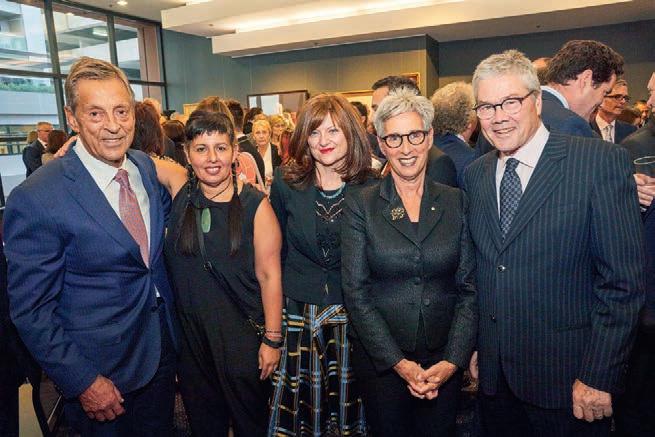
and the Commissioner of the tapestry works that hang in the foyer of Owen Dixon West and which were funded by the silks of the Bar.
At the time of going to print we are about to open the Changing Faces of the Bar photography exhibition. The exhibition is to be opened by the distinguished Australian photographer Mr Bill Henson. The exhibition features the faces of our colleagues in the 1930s, the 1980s and today and highlights the changing nature of our Bar through that period. The 700 photos taken of our colleagues in 2018 were captured by photographer Garth Oriander. The exhibition runs until 7 December 2018.
Through the course of the year we were delighted to welcome new members: Raini Zambelli, Stephen Jurica and Nicholas Modrzewski to our Committee.
The Committee looks forward to an exciting programme of unveilings in 2018/2019 of the portraits of the Hon. Mr Michael Black AC QC, the Hon. Alex Chernov AC QC and others.
This Bar Council committee was established last year, originally chaired by Susan Gatford and this year by Garry Bigmore QC. It aims to share and promulgate information about technologyled change in the legal sector, opportunities for barristers to use technology to their advantage in their day to day practices, technology changes in courts and changes to the way in which barristers may be briefed.
The Committee is working on a dedicated page on the Bar’s website to help facilitate electronic briefing practices and iPad or tablet usage in and out of court and also to draw attention to recent developments within the Committee’s charter.
The Committee has liaised regularly with BCL and joined with it in presenting two CPD sessions about cybersecurity risk minimisation. Both were very well attended and have been recorded for download by members.
Garry Bigmore QC attended the Blockchain APAC all-day event, partly sponsored by the Bar, on 29 August 2018. At the event, it was announced that a major firm of solicitors has recently partnered with IBM and CSIRO’s Data61 to establish the “Australian National Blockchain - a platform that will enable companies to join a network to use digitised contracts, exchange data and confirm the authenticity and status of legal contracts”. A “Blockchain” is a form of “Distributed Ledger Technology” expected to transform the way in which important data (especially personal and financial information) are stored securely. The underlying technology (think of it as an add-on operating system specifically for data management and security) is considered to be safe
and reliable so it is expected that financial institutions especially will build systems based on it. Barristers will need to engage with those new systems and grapple with issues including Privacy Act compliance and the need for legislative change, “smart contract” interpretation, problems inevitably resulting from software applications poorly built on the underlying platform, etc.
Susan Gatford will attend the Legal Futures Symposium to be held in Sydney on 13 September 2018.
Garry Bigmore QC has been invited to, and will attend, the Federal Court Digital Practice Forum to be held in Sydney on 5 October 2018.
The 2017-2018 financial year was a similar trading year to 2016-2017. Our team had undergone some significant changes in earlier 2017, and all seemed to settle well into their roles.
Financially, after considering membership subscriptions it is expected that when the Essoign’ s audit (currently in progress) is concluded, a small surplus will be recorded. This was a strong effort by the team, which bounced back well from the loss of the previous year.
The club will continue to focus on the growth of all revenue streams. The club has adopted a change to the menu design by ensuring that the food offering presents value for money as well as more frequent changes to menu options.
The Essoign has also managed to establish a ‘calendar of events’ throughout the year. A night at the Opera, our Henschke wine dinner and Calcutta just to mention a few which the club would like to continue for our members.
The landscape has changed however in relation to the day to day operations of the club. Increasing operational costs, award rates and in respect to the club now paying rent, it is a day to day challenge for the team. There will continue to be a strong focus on running the club as a commercial identity and ensuring that the club remains in line with industry standard for all operational costs. Keeping this in mind, the club will still endeavour to offer our members an exclusive environment with competitive prices on all menu items and services.
Trevor Monti QC Chairman
The Bar congratulates members appointed to Public, Judicial and other Office:
Supreme Court of Victoria
The Honourable Chief Justice Anne Ferguson
Court of Appeal
The Honourable Justice Richard Niall
The Honourable Justice Kim Hargrave
Trial Division
The Honourable Justice Michelle Quigley
The Honourable Justice John Champion
The Honourable Justice Matthew Connock
The Honourable Justice Melinda Richards
The Honourable Justice Kevin Lyons
County Court of Victoria
His Honour Judge Michael O’Connell
His Honour Judge Paul Higham
Her Honour Judge Aileen Ryan
His Honour Judge Trevor Wraight
Her Honour Judge Patricia Riddell
Her Honour Judge Julie Condon
Her Honour Judge Amanda (Mandy) Fox
His Honour Judge Michael Cahill
Magistrates’ Court of Victoria
His Honour Deputy Chief Magistrate Franz Holzer
Her Honour Magistrate Carolyn Burnside
Her Honour Magistrate Abigail Burchill
His Honour Magistrate David Starvaggi
Federal Court of Australia
The Honourable Justice Simon Steward
Her Honour Magistrate Tara Hartnett
Her Honour Maria (Mia) Stylianou
Victorian Civil and Administrative Tribunal
President The Honourable Justice Michelle Quigley
Senior Member Suzanne Kirton
Member Felicity Marks
Coroners Court of Victoria
His Honour Darren Bracken
Solicitor-General for the State of Victoria
Kristen Walker QC
Director of Public Prosecutions for the State of Victoria
Kerri Judd QC
Chief Crown Prosecutor for the State of Victoria
Brendan Kissane QC
Crown Prosecutor for the State of Victoria
Robyn L Harper
Kristie Churchill
Commissioner of the Victorian IBAC
The Honourable Robert Redlich QC
Victorian Inspectorate
Inspector Eamonn Moran PSM QC
Family Court of Australia
The Honourable Chief Justice John Pascoe AC CVO
The Honourable Deputy Chief Justice Edvard William Alstergren
Federal Circuit Court of Australia
His Honour Chief Judge Edvard William Alstergren
Her Honour Judge Caroline Kirton
Commonwealth Administrative Appeals Tribunal
Deputy President (part-time) Frank O’Loughlin
Senior Member Robert Cameron
Senior Member (part-time) Louie Hawas
Senior Member (part-time) Rodrigo Pintos-Lopez
Member Brian Rayment QC
Member Jason Pennell
Member Dominique Grigg
Member Amanda Mendes Da Costa
Member (part-time) Lisa Hespe
Member (part-time) Amy Wood
Supreme Court of Nauru
Dr Ian R L Freckelton QC (part-time)
The Honourable Shane Marshall (part-time)
Law Aid
(Victorian Bar Incorporated and Law Institute of Victoria)
Christopher Blanden QC
James Mighell QC
Michelle Britbart QC
Roisin Annesley
Australian Securities and Investments Commission (ASIC)
Deputy Commissioner Daniel Crennan QC
Australian Building and Construction Commission (ABCC)
Deputy Commissioner Legal Anthony (Tony) Southall QC
Supreme Court of Northern Territory
The Honourable Anthony Graham QC
Bar/BCL Liaison Committee
Aine Magee QC (Chair)
Susan Gatford
Elizabeth Ruddle
Sarah Fregon (CEO, VicBar)
Paul Clark (CEO, BCL)
Michael Wyles QC (retired from Committee 30/11/17)
Ian Whitehead (CEO, BCL) (retired from Committee 12/9/17)
Medico-Legal Standing Committee
Tim Tobin SC
Mary Anne Hartley QC
Sharon Keeling
Australian Bar Association
Jennifer Batrouney QC (Vice-President)
Law Council of Australia
Board of Directors
Justin Hannebery, Director
Dr Matthew Collins QC (Director)
Law Council of Australia (continued)
Committees and Working Groups
Access to Justice Committee
Dr David J Neal S.C. (Co-Chair)
Australian Young Lawyers Committee
Joel A Silver
Charities and Not for Profits committee
Jennifer Batrouney QC (Chair)
Competition and Consumer Law Committee
David Shavin QC
Corporations Committee
Philip D Crutchfield QC
Equal O pportunity Committee
Jacinta Forbes QC
Fiona McLeod SC
Human R ights Committee
Fiona M McLeod SC and Emrys M Nekvapil
Indigenous Legal Issues Committee
Thomas P Keely, Timothy B Goodwin and Fiona McLeod SC
Insurance Contracts Act Referral Group
Michael D G Heaton QC
Judicial Issues Working Group
Jacob (Jack) I Fajgenbaum QC and Michael J Colbran QC (Chair)
Legal Profession Futures Committee
Michael Colbran QC
Military Justice Committee
Paul A Willee RFD QC (Chair)
National Criminal Law Committee
O Paul Holdenson QC, Dr David J Neal S.C. (Co-Chair) and Michael Stanton
Past Presidents Committee
Michael Colbran QC
Fiona McLeod SC
Professional Development
Minal Vohra
Rural, Regional & Remote Lawyers Committee
Albert Dinelli
Business Law Section – Executive
Frank D O’Loughlin (Treasurer)
Business Law Section – Committees
David Shavin QC, Philip D Crutchfield QC, Dr Matthew J Collins QC, Frank D O’Loughlin and Carl Moller
Family Law Section – Executive
Minal Vohra
Family Law Section – Committees
Minal Vohra
Federal Litigation Section – Committees
George H Golvan QC, David Shavin QC, Frank D O’Loughlin, Stephen J Moloney and John R Wallace
Commonwealth Courts and Tribunals
Federal Court of Australia
Class Actions Committee
Charles Scerri QC, Wendy Harris QC, Bernard Quinn QC, Lachlan Armstrong QC
Intellectual Property User Group
David Shavin QC
User Committee
Garry Bigmore QC, Charles Scerri QC, Jennifer Batrouney QC, Helen Symon QC, Francis O’Loughlin
Supreme Court of Victoria
Victorian Legal Admissions Board
Dr Suzanne B McNicol QC and Magda Karagiannakis
Victorian Legal Admissions Committee
Jennifer J Batrouney QC, Ian G Waller QC, Lisa M Nichols QC, Samuel D Hay, Magda Karagiannakis
Retired: Kerri E Judd QC (retired from Committee on 6/3/18 upon appointment as Director of Prosecutions)
Matthew N Connock QC (retired from committee on 10/4/18 upon appointment to Supreme Court)
Victorian Legal Admissions Academic Course Appraisal Committee
Dr Ian Hardingham QC, Elizabeth Boros and Magdalini Karagiannakis
Arbitration Users’ Group
David S Levin QC, Hugh Foxcroft QC and The Honourable Justice Mark K Moshinsky QC
Chief Justice’s Rules Committee
Jonathan P Moore QC
Corporations and Commercial Court User Group
Garry T Bigmore QC, David G Collins QC, Stewart M Anderson QC QC, The Honourable Justice Mark K Moshinsky QC, Philip D Crutchfield QC, The Honourable Justice Samantha L Marks QC, Philip H Solomon QC, Michael S Osborne QC, Michael J Galvin, Lachlan W L Armstrong, Penny A Neskovcin QC, Jonathan Evans QC, Daniel J Crennan QC, Peter Fary, James DS Barber, Anton P Trichardt, Simon Rubenstein, Catherine F Gobbo, Joshua Kohn, Carl Moller and Oren Bigos
County Court of Victoria
Building Cases Users’ Group
Toby Shnookal SC, Andrew J Laird, Bernard Carr and Geraldine F Gray
Banking & Finance Users Group
Bart Carew, Samantha Cipriano, Garry Moffat and Aphrodite Kouloubaritsis
Commercial Division Users Group
Ian Percy, Peter Lithgow, Robert Cameron, Michael Gronow and Aphodite Kouloubaritsis
Criminal User Group
Peter Morrissey SC, Simon Moglia and Pardeep Tiwana
Costs Co-ordination Committee
Samuel D Hay
Dust Diseases Users’ Group
John R C Gordon and Patrick Over
Judicial Review and Appeals Users’ Group
Peter J Hanks QC, Dr Ian R L Freckelton QC, Kerri E Judd QC, Michael F Fleming QC, Stephen P Donaghue QC, Jason D Pizer QC, Rowena Orr, Christopher J Horan, Lisa De Ferrari, Rachel Ellyard, Ben Ihle, Emily Latif and Richard M Niall QC
Law Library of Victoria Committee
Dr Ian R L Freckelton QC and Ian W Upjohn CSC QC
Personal Injury User Group
Ross H Gillies QC, Timothy P Tobin S.C. and David J Martin
Probate Users’ Committee
Richard R Boaden and Shane P Newton
TEC List User Committee
George H Golvan QC, David S Levin QC, Hugh Foxcroft QC, Richard J Manly QC, Caroline E Kirton QC, Ian H Percy and Kathryn L Stynes
Victorian Compensation and Planning Users’ Group
Christopher J Canavan QC, The Hon. Stuart R Morris QC, Anthony G Southall QC, Michelle L Quigley QC, C Jim Delany QC, Christopher J Wren QC, Christopher J Townshend QC, David J Batt QC, Adrian J Finanzio S.C., Susan M Brennan S.C., Jason D Pizer QC, Nicholas J Tweedie S.C., Craig W Porter, Graeme H Peake, Matthew D Townsend, David R O’Brien MP, Lisa-Maree Lo Piccolo, Sarah J Porritt, Marita H Foley, Paul F Chiappi, Peter E O’Farrell and Nicola Collingwood
Family Property Division List Committee
Carolyn H Sparke QC and Graham W Robertson
County Court Rules Committee
Michael J Corrigan
Sex Offence List User Group
Simon Moglia
WorkCover Users’ Group
Robin P Gorton QC, Michael J Richards and Ian D McDonald
Alternative Dispute Resolution Committee
Carey Nicol and Carmel Morfuni
Civil Rules Committee
Frank Rivada and Justin Foster
Statutory Appointments
Council of Law Reporting in Victoria
Annette Charak
Council of Legal Education
Elizabeth J Boros
Melbourne Law School Advisory Council
Fiona McLeod SC and Jennifer Batrouney QC
Monash University Centre for Commercial Law and Regulatory Studies - CLARS External Advisory board
The Hon. Ray Finkelstein QC, The Hon. Justice Tony North, The Hon. Justice Tony Pagone, Dr Warwick Rothnie, Dr Oren Bigos, Mr Ian Horak
WorkCover Users’ Group
Michael Richards and Nick Horner
Legal Services Board
Peter Jopling AM QC
Legal Services Board –Fidelity Fund Claims Advisory Committee
Kevin J A Lyons QC
Monash University Dean of Law’s External Professional Advisory Committee
Paul A Willee RFD QC
Victoria University College of Law & Justice Program Advisory Committee
David H Denton RFD QC and Terry P Murphy QC
Victoria University Sir Zelman Cowen Centre Advisory Committee
Fiona M McLeod SC
Other Bodies
ACICA Board
Martin Scott QC
ACICA – Member Nominating Committee
Michael Colbran QC
Fair Work Commission Termination of Employment User Group
Yasser Bakri and Rebecca Preston
Firearms Appeals Committee
Alexandra Burt
Retiring: Dianne Mitchell
Justice Connect
Richard Wilson
Legal Practitioners Liability Committee Board
Adrian Finanzio S.C.
Legal Super Pty Ltd
Phillip Kennon QC
Mediator Standards Board - Board of Directors
Mark Hebblewhite (Chair)
National Rural Law & Justice Alliance
Anne Sheehan
VCAT Online Dispute Resolution Advisory Panel
Nicki Mollard
Victorian Law Foundation Board
Elizabeth Brimer
Victoria Law Foundation – Justice Museum Legal Reference Group
Dr David J Neal S.C.
VCAT Legal Practice List – Advocate Members
Anthony G Southall QC and Manny Garantziotis QC
Wellbeing and the Law Foundation
Philip Corbett QC (Director)
The Bar Council records with deep regret the death of the following members and past members of the Victorian Bar:
His Honour Peter Gebhardt 22 July 2017
Jillian C Fischer 21 August 2017
Dr Christopher Sexton 23 August 2017
His Honour Francis Bannatyne Lewis 29 August 2017
Noel Ackman QC 4 September 2017
Lachlan James McConchie 8 September 2017
Michael O’Dwyer 24 September 2017
Peter John Davis 2 October 2017
The Right Honourable Sir Ninian Stephen KG AK GCMG, GCVO, KBE, QC 29 October 2017
The Honourable J Daryl Davies QC 19 November 2017
Richard B Phillips 2 January 2018
The Honourable Alec James Southwell QC 26 January 2018
Bernard Paul 1 February 2018
Timothy Olsson Jacobs 27 February 2018
Professor Robert Baxt AO 13 March 2018
Professor Francis Trindade 18 March 2018
Brian William Collis QC 29 March 2018
Brian James Bourke AM 30 March 2018
Michael Kevin Connolly 5 June 2018
Margaret Ley Mandelert 16 June 2018
His Honour Joseph Raymond O’Shea QC 20 June 2018
During the year, the following Victorian judges, members and past members of the Victorian Bar were recipients of the following honours:
The Honourable Justice Victoria Bennett AO
The Honourable Howard Nathan AM QC
The Honourable Thomas (Tim) Smith AM QC
The Honourable Richard Edmonds AM SC
His Honour Chester Keon-Cohen AM
Ross Macaw QC
John Karkar QC
Julian Burnside AO QC
David Curtain QC
Jeremy Ruskin QC
William Houghton QC
Ian Hill QC
Patrick Tehan QC
Peter Hanks QC
Michele Williams QC
Julian McMahon AC
Colin Golvan AM QC
The Honourable Justice Stephen Estcourt AM
Professor Timothy Lindsey AO
Dr David Neal SC
45 Years at the Bar
Robert Richter QC
George Golvan QC
Philip Kennon QC
Terence Casey QC
Remy van de Wiel QC
Paul O’Dwyer SC
Keith Oderberg
Joseph Toal
George Slim
Don Just
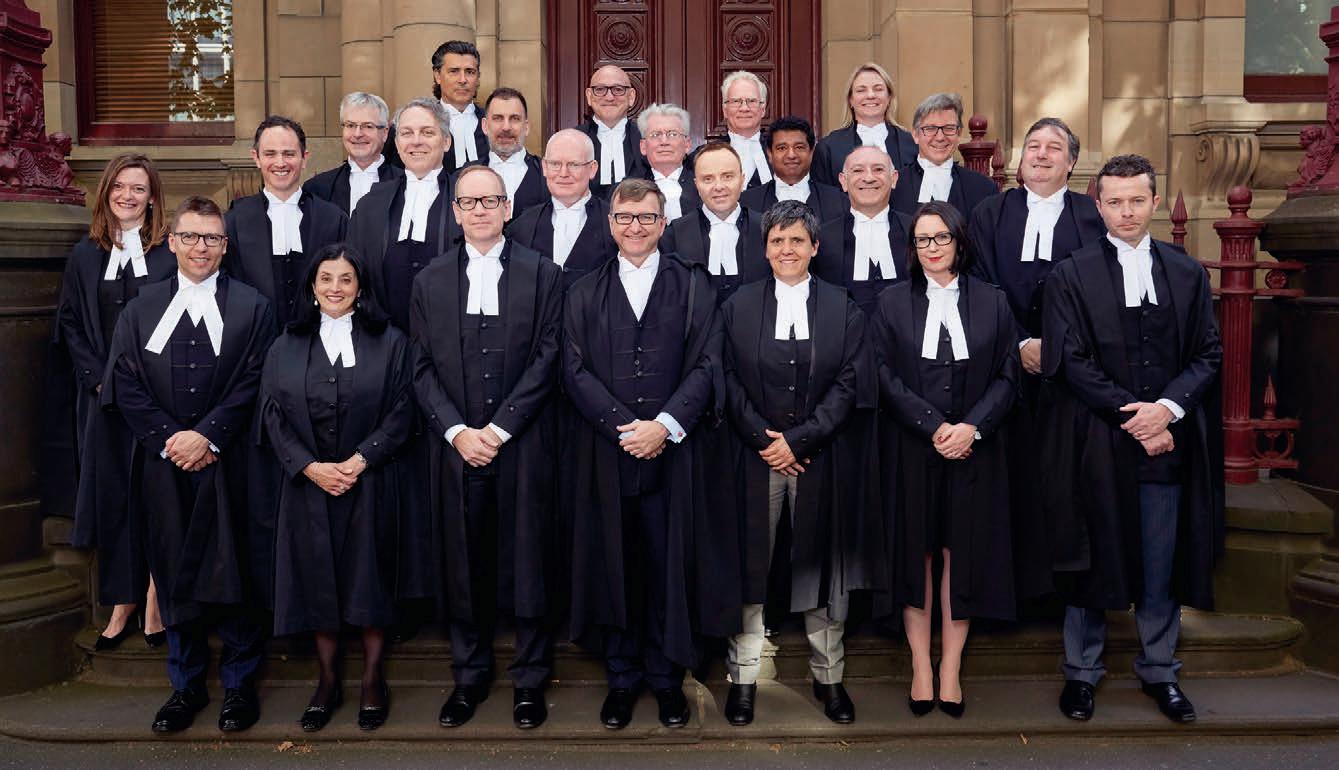
SENIOR COUNSEL: Far back row (L-R): Marcus Clarke QC, Paul L Ehrlich QC, William Guy Gilbert
Middle row: Claire M Harris QC, Stewart J Maiden QC, Paul J Hayes QC, Julian P McMahon AC SC, David J N Purcell S.C., Michael W Wise QC, Michael Gronow QC
Front row: Robert Heath QC, Minal Vohra S.C., Craig W Dowling S.C., Mark Irving QC, Lisa De Ferrari S.C., Lisa Nichols QC and Stephen H Parmenter QC
Victoria’s newest silks are:
William Guy Gilbert
Mark John Gibson
Marcus Clarke
Paul Lawrence Ehrlich
Michael Wolf Wise
Paul James Hayes
Craig William Dowling
Scott William Stuckey
Michael Geoffrey Rees Gronow
Garry John Fitzgerald
Julian Paul McMahon AC
Scott Robert Johns
Suresh Rajkumar Senathirajah
Minal Vohra
David Joseph Nicolas Purcell
Mark Anthony Irving
Stephen Howard Parmenter
Claire Michelle Harris
Robert Andrew Heath
Lisa Michelle Nichols
Sally Amanda Flynn
Stewart John Maiden
Lisabella Gianna De Ferrari
The following is a statistical profile of membership of the Bar Association and a listing of those joining, leaving or transferring their membership during the year ended 30 June 2018.
The following persons signed, re-signed, transferred or were removed from the Roll of Counsel:
Practising Counsel)
Signed Felicity Gerry QC, Nicholas Doukas, Juliette Buxton, Daniel Preston, James Robert Strong, Felicity Jane Blair, Maria Tenace, Xuelin Teo, Ivanco Hristovski, Zachary de Kievit, Marion Alice Jane Isobel, Laura Ellen Hilly, Karen Elise Chibert, Adam Jay Maloney, Matthew Meng, William John Newland, Jessica Lee Willard, Albert Lloyd Ounapuu, Joe Connolly, Sandra Wendlandt, Patrick Gordon, Mathew James Kenneally, Lindsay John Hogan, Roxanne Melanie Burd, Christopher Edwards,
Katarina Ljubicic, Simon Fuller, Timothy Frederick Bennett Farhall, Samuel Orson Burt, Lucinda Anne Thies, Tristan Nathanielsz, Rachel Louise Matson, Willem John Drent, Katrina Nicola Chow, Caitlin Riannon Dwyer, Jane Lucy Gregory, Ffyona Livingstone Clark, Oliver Trand Lesage, Grant Daniel Lubofsky, Henry (Harry) Beauchamp Lewis, Rishi Nathwani, Vincent Tallarida Felicity A Marks, Angela Moran, Maryann S Gassert, Timothy Paul Smurthwaite, Benjamin Hill, Pauline Chia,
Glenn Mark Barr, Joanne Poole, Amit Malik, George Themis Glezakos, Serena Vashti Armstrong, James Philip Stoller, Amanda Victoria Melanie Carruthers, Geoffrey Travers Lake, Tanya Skvortsova, Hugo Moodie, Matthew Jonathan Tennant, Nicholas Walter, Simone Tatas, Andrea Vassiliki Skinner, Andrew Charles Richards White, Stephen Charles Scully, Lachlan Molesworth, Sally Bastick, William Derrel Barker, Nonni Harriet Sdraulig, Lachlan David John Cameron, Edwina
Re-signed
Keynes, Mitchell Rhys Grady, Julie Yu Zhou, Kate Ballard, Abilene Reena Singh, Luciana Veronika Drago, Alexandra Kimberley Metherell, Andrew Charles Roe, James David Claridge, Amy Maree Hando, Caroline Dawes, James Portelli, Fabian Charles Brimfield, Paul David Reynolds, Joanna Lucy Dodd, Jonathan William McCoy, Simon Neish Kelly, Ramon Fowler, William James Stephenson, Callum Francis Ellemor Dawlings, Nicholas Andre Modrzewski
Eric Wawra, Robert C Nitti, Alexandra C Burt, Damian P Ballan, Jacob John Pruden, Darren Anthony Ferrari, Benjamin Leon Rozenes
Transfers from Andrew F Hamlyn-Harris, The Honourable Michael Black AC QC, Ross Macaw QC, Jack D Hammond QC, Edward Heerey QC, Daryl G Wraith, Jeffrey D Loewenstein, Mary Baczynski, Michael J O’Brien, Shane G S Collins, Paul M Moran, David J Havin, Paul V Guggenheimer, John M Buxton, David Forbes, Judith Bornstein, Belinda Lim, Bruce M Cohen, Brian Halpin, Malcolm A Strang, Cheri Lee, Jason Pennell, Sophie Mirabella, Amy Brennan, Keir Dernelly, Richard Scheelings, Anthony G Southall QC, Michael O’Connell S.C., Carolyn M Burnside, David Starvaggi, Michael Stiffe, Aileen M Ryan QC, Paul J F Higham, Brian J Bourke AM, Amanda Mendes Da Costa, Robert L Dean, Edvard William Alstergren
QC, Trevor E Wraight QC, Patricia R Riddell, Richard M Niall QC, Simon Steward QC, Kristen L Walker QC, Dinash Daniel, Eamonn P A Moran PSM QC, Julie Condon QC, Michelle L Quigley QC, Alan Hebb, Caroline Kirton QC, Chiry Chen, Robert N Cameron, David M Clarke, Suzanne A Kirton, Darren J Bracken, Beata Armaty, Peter Berman, Rodney Willcox, Patrick L Bourke, Matthew N Connock QC, Guy P Colquhoun, Lynda White, Erin Ramsay, Kevin J A Lyons QC, Amanda (Mandy) Claire Fox QC, Tara K Hartnett, Robyn L Harper, Kristie Churchill, George G McGrath QC, James J Isles, Michael P Cahill S.C, Daniel J Crennan QC, Maria (Mia) Stylianou
Transfers to Norman Franzi, David Wood, Dan Coombes, Sean Radich, F. George A Beaumont QC, Julian P Siggins, Jaclyn M Lontos, Sashi Maharaj QC, Susan M K Borg, Jane C Forsyth, Anthony G Southall QC, Andrew J Grant, Stephen G O’Bryan QC, The Honourable Chris N Jessup, The Honourable Justice G Tony Pagone, Vincent Tallarida
Removed from Dr Keith Kendall, Amanda L Forrester, Rose Cameron, Darren A Ferrari, Timothy Tyler, Neil McAteer, Robert Nitti, Rachel Waters, Sylvia Maramis, Nigel Evans, Mark Richardson, Rodney MacDonald, Glenn N Holden, Justin L Podmore, Edwin J Lorkin, Glen A Pauline
(Crown Prosecutors & P ublic Defenders)
Transfers from Peter N Rose QC, Susan M K Borg, Andrew J Grant, Gavin J C Silbert QC
Transfers to Patrick L Bourke, Erin Ramsay
Name removed Rebekah S Sleeth, Selena J McCrickard
and Overseas Counsel)
Signed Geoffrey Neil Gunn, Kenneth Leslie John Leigh, Julian Samuel Zmood, Koulla Roussos, Peter Douglas van Eps
Transfers from Dan Coombes, Sean Radich, The Honourable Richard K R Alston AO, Brian Rayment QC, Andrew Barrie, Dominique Grigg, Julian P Siggins, Neville G Rochow S.C, David M.J. Bennett AC QC, The Honourable David H Lloyd QC, Felicity Gerry QC, Sashi Maharaj QC, Sir John Walsh of Brannagh
Transfers to
Edward Heerey QC, David Forbes, Richard Scheelings, Ellen Grant, Dinash Daniel
Removed from
Robert G Bain QC, George N Kalimnios effective 22 July 2017, The Honourable Greg James AM QC, Christopher T Barry QC, David Higgs S.C., Frank G Lever S.C., John Cooper S.C., Stuart M Littlemore QC, Rod S Lister QC, Jeanette E Richards, Derek M Minus (2015), Michael G Rudge QC, Chris Tam, Kym Tredrea, Katrina Howard SC, Kenneth L J Leigh
(Vic Practising Counsel temporarily absent without current PC)
Transfers from
David Wood, Ellen Grant, Jaclyn M Lontos, Jane C Forsyth, Beata Armaty, Kristen Rose
Transferred To
Brian Rayment QC (appointed to the Commonwealth Administrative Appeals Tribunal)
Jason Pennell (appointed to the Commonwealth Administrative Appeals Tribunal)
Amy Brennan (Victorian Legal Aid)
Dominique Grigg (appointed to the Commonwealth Administrative Appeals Tribunal)
His Honour Graham Anderson
(Reserve Judge, County Court of Victoria)
Anthony G Southall QC (appointed Deputy Commissioner Legal, Australian Building and Construction Commission)
Michael O’Connell S.C.
(appointed to the County Court of Victoria)
Carolyn M Burnside
(appointed to the Magistrates’ Court of Victoria)
David Starvaggi
(appointed to the Magistrates’ Court of Victoria)
Abigail I Burchill
(appointed to the Magistrates’ Court of Victoria)
Aileen M Ryan QC (appointed to the County Court of Victoria)
Paul J F Higham (appointed to the County Court of Victoria)
The Honourable Anthony Graham QC (appointed to the Supreme Court of the Northern Territory)
Amanda Mendes Da Costa (appointed to the Commonwealth Administrative Appeals Tribunal)
Edvard William Alstergren QC (appointed Chief Judge of the Federal Circuit Court of Australia and Deputy Chief Justice of the Family Court of Australia)
Trevor E Wraight QC
(appointed to the County Court of Victoria)
Patricia R Riddell (appointed to the County Court of Victoria)
Simon Steward QC
(appointed to the Federal Court of Australia)
Kristen L Walker QC
Transfers to
Shane G S Collins, Malcolm A Strang, Keir Dernelly, Vincent Tallarida, Lynda White, James J Isles
Bennett
(appointed as Solicitor-General of Victoria)
Eamonn P A Moran PSM QC
(appointed as Inspector – The Victorian Inspectorate)
Julie Condon QC (appointed to the County Court of Victoria)
Michelle L Quigley QC
(appointed to the Supreme Court of Victoria)
John R Champion SC
(appointed to the Supreme Court of Victoria)
Caroline Kirton QC
(appointed to the Federal Circuit Court of Australia)
Robert N Cameron (appointed to the Commonwealth Administrative Appeals Tribunal)
Suzanne A Kirton (appointed as Senior Member of the Victorian Civil and Administrative Tribunal)
Darren J Bracken
(appointed as Coroner at the Coroners Court of Victoria)
Felicity A Marks (appointed to the Victorian Civil and Administrative Tribunal)
Angela Moran (appointed to the Post Sentence Authority)
Matthew N Connock QC
(appointed to the Supreme Court of Victoria)
Melinda J Richards SC (appointed to the Supreme Court of Victoria)
Kevin J A Lyons QC
(appointed to the Supreme Court of Victoria)
Amanda (Mandy) Claire Fox QC (appointed to the County Court of Victoria)
Tara K Hartnett
(appointed to the Magistrates’ Court of Victoria)
Robyn L Harper (appointed Crown Prosecutor)
Kristie Churchill (appointed Crown Prosecutor)
Michael P Cahill S.C
(appointed to the County Court of Victoria)
Maria (Mia) Stylianou
(appointed to the Magistrates’ Court of Victoria)
Transfers from
His Honour Judge Graham Anderson, The Honourable Justice Robert Redlich, The Honourable Chief Justice Marilyn Warren AC, His Honour Judge Roy F Punshon, Her Honour Judge Carolyn Douglas, His Honour Judge Ian L Gray, The Honourable Justice Thomas H Gray, The Honourable Chief Justice Diana Bryant AO, The Honourable Justice John R Sulan (2016), The Honourable David H Lloyd QC, His Honour Judge Michael G McInerney, Anthony G Southall Q.C., Stephen G O’Bryan QC, Michael J Halliday, Her Honour Magistrate Jillian M Crowe, The Honourable Justice G Tony Pagone, The Honourable Justice Mark K S Weinberg AO, The Honourable Justice Peter N Vickery, The Honourable Justice Jack H L Forrest, Honourable Justice Robert Stanley Osborn, the Honourable Justice Lex Lasry AM
Transfers from Norman Franzi, F. George A Beaumont QC, His Honour Graham Anderson, The Honourable Anthony Graham QC, The Honourable Chris N Jessup
Transfers to
Andrew F Hamlyn-Harris, His Honour Judge Graham Anderson, The Honourable Michael Black AC, QC, Ross Macaw QC, Jack D Hammond QC, Daryl G Wraith, Jeffrey D Loewenstein, Mary Baczynski, Michael J O’Brien, Paul M Moran, David J Havin, Paul V Guggenheimer, John M Buxton, Judith Bornstein, Belinda Lim, Bruce M Cohen, The Honourable Chief Justice Marilyn Warren AC, The Honourable Richard K R Alston AO, Brian Halpin, Andrew Barrie, Cheri Lee, Sophie Mirabella, The Honourable Justice Robert Redlich, Michael Stiffe, Neville G Rochow S.C, David M.J. Bennett AC, QC, Brian J Bourke AM, His Honour Judge Roy F Punshon, Peter N Rose QC, Her Honour Judge Carolyn Douglas, His Honour Judge Ian L Gray, Robert L Dean, The Honourable Justice Thomas H Gray (2015), The Honourable Chief Justice Diana Bryant AO, The Honourable Justice John R Sulan (2016), His Honour Judge Michael G McInerney, Alan Hebb, Laurie C Robson, Michael J Halliday, Chiry Chen, Her Honour Magistrate Jillian M Crowe, David M Clarke, Gavin J C Silbert QC, Sir John Walsh of Brannagh, Peter Berman, Rodney Willcox, The Honourable Justice Mark K S Weinberg AO, The Honourable Justice Peter N Vickery, Guy P Colquhoun, The Honourable Justice Jack H L Forrest, George G McGrath QC, Honourable Justice Robert Stanley Osborn, the Honourable Justice Lex Lasry AM, Daniel J Crennan QC
Transfers from Laurie C Robson
Christopher Francis O’Meara, Eric Wawra, Norman Franzi, David Wood, Dan Coombes, Sean Radich, F. George A Beaumont QC, Ellen Grant, Robert C Nitti, Julian P Siggins, Alexandra C Burt, Damian P Ballan, Jaclyn M Lontos, Felicity Gerry QC, Nicholas Doukas, Juliette Buxton, Daniel Preston, James Robert Strong, Felicity Jane Blair, Maria Tenace, Xuelin Teo, Ivanco Hristovski, Zachary de Kievit, Marion Alice Jane Isobel, Laura Ellen Hilly, Karen Elise Chibert, Adam Jay Maloney, Matthew Meng, William John Newland, Jessica Lee Willard, Albert Lloyd Ounapuu, Joe Connolly, Sandra Wendlandt, Patrick Gordon, Mathew James Kenneally, Lindsay John Hogan, Roxanne Melanie Burd, Christopher Edwards, Katarina Ljubicic, Simon Fuller, Timothy Frederick Bennett Farhall, Samuel Orson Burt, Lucinda Anne Thies, Tristan Nathanielsz, Rachel Louise Matson, Willem John Drent, Katrina Nicola Chow, Caitlin Riannon Dwyer, Jane Lucy Gregory, Ffyona Livingstone Clark, Oliver Trand Lesage, Grant Daniel Lubofsky, Henry (Harry) Beauchamp Lewis, Sashi Maharaj QC, Jacob John Pruden, Susan M K Borg, Jane C Forsyth, Darren Anthony Ferrari, Anthony G Southall Q.C., Andrew J Grant, Stephen G
O’Bryan QC, The Honourable Chris N Jessup, Rishi Nathwani, the Honourable Justice G Tony Pagone, Maryann S Gassert, Timothy Paul Smurthwaite, Benjamin Hill, Pauline Chia, Glenn Mark Barr, Joanne Poole, Amit Malik, George Themis Glezakos, Serena Vashti Armstrong, James Philip Stoller, Amanda Victoria Melanie Carruthers, Geoffrey Travers Lake, Tanya Skvortsova, Hugo Moodie, Matthew Jonathan Tennant, Nicholas Walter, Simone Tatas, Andrea Vassiliki Skinner, Andrew Charles Richards White, Stephen Charles Scully, Lachlan Molesworth, Sally Bastick, William Derrel Barker, Nonni Harriet Sdraulig, Lachlan David John Cameron, Edwina Keynes, Mitchell Rhys Grady, Julie Yu Zhou, Kate Ballard, Abilene Reena Singh, Luciana Veronika Drago, Alexandra Kimberley Metherell, Andrew Charles Roe, James David Claridge, Amy Maree Hando, Caroline Dawes, James Portelli, Fabian Charles Brimfield, Paul David Reynolds, Joanna Lucy Dodd, Jonathan William McCoy, Simon Neish Kelly, Ramon Fowler, William James Stephenson, Callum Francis Ellemor Dawlings, Nicholas Andre Modrzewski, Benjamin Leon Rozenes
Registered No. A0034304S
Owen Dixon Chambers East
Level 5 / 205 William Street
Melbourne Victoria 3000
T: 03 9225 7111
F: 03 9225 6068
E: vicbar@vicbar.com.au
W: www.vicbar.com.au
Dr Matthew J Collins QC (President), Ms Wendy A Harris QC (Senior Vice-President), Mr Simon E Marks QC (Junior Vice-President), Mr Samuel D Hay (Hon Treasurer), Mr Stewart J Maiden QC (Assistant Hon Treasurer), Mr O Paul Holdenson QC, Dr Ian R L Freckelton QC, Ms Caroline M Kenny QC, Ms Jacinta M Forbes QC, Ms Áine M Magee QC, Ms Fiona Ellis, Mr P Justin Hannebery, Ms Susan Gatford, Mr Justin P Wheelahan, Ms Elizabeth H Ruddle, Ms Sarah J Keating, Ms Kathleen E Foley, Ms Barbara A Myers, Ms Erin W Hill, Ms Julia Frederico, Mr Daniel D Nguyen, Nicole Papaleo (Hon Secretary) and Andrew Bell (Assistant Hon Secretary)
Barristers Chambers Limited
ACN 004 454 004
Board of Directors
Mr P Anastassiou QC (Chairman), Mr J I Fajgenbaum QC (Deputy Chairman), Mr A J Finanzio SC, Ms A J M Williams, Ms P A Neskovcin QC, Mr P Clark (CEO and Managing Director)
ACN 624 652 357
Board of Directors
Mr P Anastassiou QC, Mr P Clark
ACN 004 640 108
Dr Matthew J Collins QC, Mr Samuel D Hay PART X
The officers, members of the Council of the Victorian Bar Incorporated, submit herewith the annual financial report of the Association for the financial year ended 30 June 2018. In order to comply with the provisions of the Associations Incorporation Reform Act 2012 and generally appropriate good practice disclosure, the Officers report as follows:
The names of the Officers of the Association during or since the end of the financial year are included in Part II of the annual report under Bar Council, except for the following who retired from the previous Bar Council during the year:
Ms Michelle L Quigley QC
The Victorian Bar Incorporated is a professional association for lawyers practising solely as barristers. As well as serving its barrister members, the Bar serves the public interest through its activities in improving access to justice and law reform and its pro bono work. The Bar has two wholly owned subsidiary companies: Barristers Chambers Limited owns and leases buildings, which are provided as chambers to barristers, and provides telephone and internet services to members of the Bar; and The Melbourne Bar Pty Ltd which is a non-operating nominee company. During the year Barristers Chambers Limited acquired Opus Workspaces Pty Ltd which provides serviced office space.
During the financial year ended 30 June 2018 the Association achieved a surplus from ordinary activities of $704,553 (2017: $382,199) after an income tax benefit of $54,545 (2017: $233,514). Its consolidated surplus from ordinary activities was $29,769,828 (2017: $23,954,490) after income tax expense of $7,948,564 (2017: $6,048,150).
Except as set out in the accompanying financial reports, there was no significant change in the state of affairs of the Association during the financial year.
There has not been any matter or circumstance occurring subsequent to the end of the financial year that has significantly affected, or may significantly affect, the operations of the Association, the results of those operations, or the state of affairs of the Association in future financial years.
Substantial changes in the operations of the Association are ordinarily determined by a vote of members which are communicated other than through the Annual Report.
The Association is not subject to any significant environmental regulations under Australian law.
The Association is incorporated under the Associations Incorporation Act 1981 (Vic). It is precluded under the Act and its Constitution from paying a dividend to its members. The Association is a not for profit organisation.
During the financial year, the Association paid a premium in respect of a contract insuring the Officers of the Association (as named above and in Part II of the Annual Report) and all Executive Officers of the Association and of any related body corporate against a liability incurred as an officer or executive officer to the extent permitted by the Association’s Constitution.
The contract of insurance prohibits disclosure of the nature of the liability and the amount of the premium.
The Association has not otherwise, during or since the financial year, except to the extent permitted by law, indemnified or agreed to indemnify an officer or auditor of the Association or of any related body corporate against a liability incurred as such an officer or auditor.
No person has applied for leave of court to bring proceedings on behalf of the Association or to intervene in any proceedings to which the Association is a party for the purpose of taking responsibility on behalf of the Association for all or part of those proceedings. Signed in accordance with a resolution of the Council made pursuant to the Constitution of the Victorian Bar.
Sections 94 (2) (b), 97 (2) (b) and 100 (2) (b)
ANNUAL STATEMENTS GIVE TRUE AND FAIR VIEW OF FINANCIAL POSITION OF INCORPORATED ASSOCIATION
We, Matthew Collins QC and Samuel Hay, being President and Honorary Treasurer of the Victorian Bar Council respectively, and members of the Victorian Bar Council, which is the Committee of the Victorian Bar Incorporated, certify that:
The financial statements (and notes thereto) attached to this certificate give a true and fair view of the financial position of The Victorian Bar Incorporated during and at the end of the financial year of the association ended on 30 June 2018.
Dated this 12th day of October 2018
On behalf of the Officers

Dr Matthew Collins QC
President

Mr Samuel Hay
Honorary Treasurer






Opinion
We have audited the financial report of The Victorian Bar Incorporated and its subsidiaries (the “Group”), which comprises the statement of financial position as at 30 June 2018, the statement profit or loss and other comprehensive income, statement of changes in equity and statement of cash flows for the year then ended, and notes to the financial statements, including a summary of significant accounting policies and declaration by the Officers.
In our opinion the accompanying financial report presents fairly, in all material respects, the Group’s financial position as at 30 June 2018, and of its financial performance and its cash flows for the year then ended in accordance with Australian Accounting Standards to the extent described in Note 3 to the financial report, the Associations Incorporation Reform Act 2012 and the Constitution.
We conducted our audit in accordance with Australian Auditing Standards. Our responsibilities under those standards are further described in the Auditor’s Responsibilities for the Audit of the Financial Report section of our report. We are independent of the Group in accordance with the ethical requirements of the Accounting Professional and Ethical Standards Board’s APES 110 Code of Ethics for Professional Accountants (the Code) that are relevant to our audit of the financial report in Australia. We have also fulfilled our other ethical responsibilities in accordance with the Code.
We believe that the audit evidence we have obtained is sufficient and appropriate to provide a basis for our opinion.
We draw attention to Note 3 to the financial report, which describes the basis of accounting. The financial report has been prepared for the purpose of fulfilling the Officers financial reporting responsibilities under the Associations Incorporation Reform Act 2012 and the Constitution. As a result, the financial report may not be suitable for another purpose. Our opinion is not modified in respect of this matter.
The Officers are responsible for the other information. The other information comprises the information included in, or distributed with the annual, but does not include the financial report and our auditor’s report thereon.
Our opinion on the financial report does not cover the other information and we do not express any form of assurance conclusion thereon.
Deloitte Touche
Tohmatsu
ABN 74 490 121 060
550 Bourke Street
Melbourne VIC 3000
GPO Box 78
Melbourne VIC 3001
Australia
DX: 111
Tel: +61 (0) 3 9671 7000
Fax: +61 (0) 3 9671 7001
www.deloitte.com.au
In connection with our audit of the financial report, our responsibility is to read the other information and, in doing so, consider whether the other information is materially inconsistent with the financial report or our knowledge obtained in the audit or otherwise appears to be materially misstated.
If, based on the work we have performed, we conclude that there is a material misstatement of this other information; we are required to report that fact. We have nothing to report in this regard.
The Officers are responsible for the preparation and fair presentation of the financial report in accordance with Australian Accounting Standards and the Associations Incorporation Reform Act 2012 and the Constitution and for such internal control as the Officers determine is necessary to enable the preparation and fair presentation of the financial report and is free from material misstatement, whether due to fraud or error.
In preparing the financial report, the Officers are responsible for assessing the Group’s ability to continue as a going concern, disclosing, as applicable, matters related to going concern and using the going concern basis of accounting unless the officers either intend to liquidate the Group or to cease operations, or have no realistic alternative but to do so.
Our objectives are to obtain reasonable assurance about whether the financial report as a whole is free from material misstatement, whether due to fraud or error, and to issue an auditor’s report that includes our opinion. Reasonable assurance is a high level of assurance, but is not a guarantee that an audit conducted in accordance with the Australian Auditing Standards will always detect a material misstatement when it exists. Misstatements can arise from fraud or error and are considered material if, individually or in the aggregate, they could reasonably be expected to influence the economic decisions of users taken on the basis of this financial report.
As part of an audit in accordance with the Australian Auditing Standards, we exercise professional judgement and maintain professional scepticism throughout the audit. We also:
› Identify and assess the risks of material misstatement of the financial report, whether due to fraud or error, design and perform audit procedures responsive to those risks, and obtain audit evidence that is sufficient and appropriate to provide a basis for our opinion. The risk of not detecting a material misstatement resulting from fraud is higher than for one resulting from error, as fraud may involve collusion, forgery, intentional omissions, misrepresentations, or the override of internal control.
› Obtain an understanding of internal control relevant to the audit in order to design audit procedures that are appropriate in the circumstances, but not for the purpose of expressing an opinion on the effectiveness of the Group’s internal control.
› Evaluate the appropriateness of accounting policies used and the reasonableness of accounting estimates and related disclosures made by the officers.
› Conclude on the appropriateness of the Officers’ use of the going concern basis of accounting and, based on the audit evidence obtained, whether a material uncertainty exists related to events or conditions that may cast significant doubt on the Entity’s ability to continue as a going concern. If we conclude that a material uncertainty exists, we are required to draw attention in our auditor’s report to the related disclosures in the financial report or, if such disclosures are inadequate, to modify our opinion. Our conclusions are based on the audit evidence obtained up to the date of our auditor’s report. However, future events or conditions may cause the Group to cease to continue as a going concern.
› Evaluate the overall presentation, structure and content of the financial report, including the disclosures, and whether the financial report represents the underlying transactions and events in a manner that achieves fair presentation.
We communicate with the Officers regarding, among other matters, the planned scope and timing of the audit and significant audit findings, including any significant deficiencies in internal control that we identify during our audit. DELOITTE TOUCHE TOHMATSU


Robert D D Collie Partner
Chartered Accountants Melbourne, 12 October 2018
The Officers have determined that the Victorian Bar Inc (the “Association”) is not a reporting entity because in the opinion of the Officers there are unlikely to exist users of the financial report who are unable to command the preparation of reports tailored so as to satisfy specifically all of their information needs. Accordingly this special purpose financial report has been prepared to satisfy the Officer’s reporting requirements under the Victorian Bar Inc’s Constitution and the Associations Incorporation Reform Act 2012.
The Officers of the Association declare that:
1. The financial statements and notes thereto, as set out on pages 52 to 69:
a. Comply with accounting standards, the Associations Incorporation Reform Act 2012 and the reporting requirements under the Victorian Bar’s Constitution; and
b. Give a true and fair view of the financial position as at 30 June 2018 and performance for the year ended on that date, in accordance with the accounting policies described in Note 3 to the financial statements, of the Association and the Group entities.
2. In the Officers opinion there are reasonable grounds to believe that the Association will be able to pay its debts as and when they become due and payable.
Signed in accordance with a resolution of the Council of the Association
On behalf of the Officers

Dr Matthew Collins QC President
Melbourne, 12 October 2018

Mr Samuel Hay Honorary Treasurer
Melbourne, 12 October 2018
Statement of profit or loss and other comprehensive income for the year ended 30 June 2018
(158,703) (86,184) Lease expenses (11,511,159)(9,371,996)(1,097,699)(1,020,839)
Other comprehensive income net of income tax
Items that will not be reclassified subsequently to profit or loss: Total comprehensive income for the year
The accompanying notes form part of these financial statements.
The accompanying notes form part of these financial statements.
3,764,8692,435,814
Statement of changes in equity for the year ended 30 June 2018
29,769,82829,769,828
29,769,82829,769,828
192,402,950192,402,950
The accompanying notes form part of these financial statements.
Cash flows from operating activities
Receipts from members and customers 36,418,17741,185,3295,239,4535,812,916 LSB reimbursements and contributions 777,767755,750 777,767755,750
Interest received (2,089,602)13,886 - -
Payments to suppliers and employees (29,177,341)(26,245,298)(6,423,981)(4,907,342)
Finance expenses paid -(1,779,230) - -
Income tax paid / (used in) (216,694)(1,900,625) 147,037 (76,497)
Net cash generated by operating activities 19(b) 5,712,30712,029,812(259,724)1,584,527
Cash flows from investing activities
Payments for financial assets
(1,363,541)(2,497,547)(1,363,543)(2,497,547)
Payments for intangible assets (41,192)(270,110) (41,192)(270,110)
Proceeds from dividends received from subsidiary - - 550,000Proceeds
Payments for property, plant and equipment (7,762,965)(2,614,547)(109,990)(75,436)
Net cash used in investing activities (10,343,073)(12,446,607)(964,725)(2,718,282)
Cash flows from financing activities
Proceeds from borrowings 1,000,0004,000,000
Net cash generated by financing activities 1,000,0004,000,000 - -
Net (decrease)/increase in cash and cash equivalents (3,630,766)3,583,205(1,224,449)(1,133,455)
Cash and cash equivalents at the beginning of the year 12,368,7998,785,5944,625,2565,758,711
Cash and cash equivalents at the end of the year 19(a) 8,738,03312,368,7993,400,8074,625,256
The accompanying notes form part of these financial statements.
The Victorian Bar Inc (the Association) is incorporated under the Associations Incorporation Reform Act 2012, Victoria and operates in Australia.
The registered office and the principal place of business of the Association is: Level 5, 205 William Street Melbourne Victoria 3000
The Association is a private, voluntary, self-funded, non-profit, professional association of barristers who practise in Victoria. Its principal activities during the period related to the provision of regulatory and other services to barristers who practice in Victoria.
2.1 Amendments to Accounting Standards that are mandatorily effective for the current reporting period
The entity has adopted all of the new and revised Standards and Interpretations issued by the Australian Accounting Standards Board (the AASB) that are relevant to their operations and effective for an accounting period that begins on or after 1 July 2017. These include:
› AASB 1048 Interpretation of Standards;
› AASB 2016-1 Amendments to Australian Accounting Standards – Recognition of Deferred Tax Assets for Unrealised Losses;
› AASB 2016-2 Amendments to Australian Accounting Standards – Disclosure Initiative: Amendments to AASB 107; and
› Amendments to Australian Accounting Standards – Deferral of AASB 15 for Not-for Profit Entities.
2.2 New and revised Australian Accounting Standards in issue but not yet effective
At the date of authorisation of the financial statements, the Group has not applied the following new and revised Australian Accounting Standards, Interpretations and amendments that have been issued but are not yet effective:
Standards/amendment
AASB 9 Financial Instruments
AASB 15 Revenue from Contracts with Customers, AASB 2014-5 Amendments to Australian Accounting Standards arising from AASB 15, AASB 2015-8 Amendments to Australian Accounting Standards
– Effective Date of AASB 15, and AASB 2016-3 Amendments to Australian Accounting Standards – Clarifications to AASB 15
AASB 16 Leases
AASB 1058 Income of Not-for-Profit Entities, and AASB 2016 -8 Amendments to Australian Accounting Standards – Australian Implementation Guidance for Not-for-Profit Entities
AASB 2017-1 Amendments to Australian Accounting Standards
– Transfers of Investment Property, Annual Improvements 2014-2016 Cycle and Other Amendments
AASB 2017-3 Amendments to Australian Accounting Standards
– Further Annual Improvements 2014-2016
AASB 2018-1 Amendments to Australian Accounting Standards
– Annual Improvements 2015-2017 Cycle
The potential impact of the revised Standards/Interpretations on the Associations financial statements has not yet been determined.
In addition, at the date of authorization of the financial statements the following IASB Standards and IFRIC Interpretations were on issue but not yet effective, but for which Australian equivalent Standards and Interpretations have not yet been issued.
Standard/amendment
Amendments to References to the Conceptual Framework in IFRS
The Officers have determined that the Association is not a reporting entity because, in the opinion of the Officers, there are unlikely to exist users of the financial report who are unable to command the preparation of reports tailored so as to satisfy specifically all of their information needs. Accordingly this special purpose financial report has been prepared to satisfy the Officer’s reporting requirements under the Victorian Bar Inc’s Constitution and the Associations Incorporation Reform Act 2012.
For the purpose of preparing the financial statement, the Association is a for profit entity.
The financial report has been prepared in accordance with the Associations Incorporation Reform Act 2012, the Victorian Bar Inc. Constitution, the basis of accounting specified by all Accounting Standards and Interpretations, and the disclosure requirements of Accounting Standards AASB 101 ‘Presentation of Financial Statements’, AASB 107 ‘Statements of Cash Flow’, AASB 108 Accounting Policies, Changes in Accounting Estimates and Errors, and AASB 1054 Australian Additional Disclosures’.
The financial report includes the separate financial statements of the Association and the consolidated financial statements of the Group.
The financial report has been prepared on the basis of historical cost, except for the revaluation of certain non-current assets and financial instruments. Cost is based on the fair values of the consideration given in exchange for assets. All amounts are presented in Australian dollars, unless otherwise noted.
In the application of the Group’s accounting policies, management is required to make judgments, estimates and assumptions about carrying values of assets and liabilities that are not readily apparent from other sources. The estimates and associated assumptions are based on historical experience and various other factors that are considered to be relevant. Actual results may differ from these estimates.
The estimates and underlying assumptions are reviewed on an ongoing basis. Revisions to accounting estimates are recognised in the period in which the estimate is revised if the revision affects only that period, or in the period of the revision and future periods if the revision affects both current and future periods. Accounting estimates are made in relation to the allowance for doubtful debts. Refer to note 8.
The fair values of properties are calculated using a combination of market sales comparison and capitalisation rate. To assist with calculating reliable estimates, the Group uses external valuers on at least a biennial basis. The fair values are a best estimate, but may differ to the actual sales price if the properties were to be sold. The key judgements for each valuation method are explained below:
› Market sales comparison: Utilises recent sales of comparable properties, adjusted for any differences including the nature, location and lease profile;
› Capitalisation rate: Capitalises the fully-leased net income for a property into perpetuity at an appropriate capitalisation rate. The fully-leased net income is based on market rents, operating costs and future income on vacant space. The capitalisation rate reflects the nature, location and tenancy profile of the property, together with current market evidence and sales of comparable properties.
The following significant accounting policies have been adopted in the preparation and presentation of the financial report:
The consolidated financial statements incorporate the financial statements of the Association and entities controlled by the Association (its subsidiaries referred to in note 10) (referred to as ‘the Group’ in these financial statements). Control is achieved where the Association has the power to govern the financial and operating policies of an entity so as to obtain benefits from its activities.
All inter-company balances and transactions between entities in the consolidated entity, including any unrealised profits or losses, have been eliminated on consolidation.
Where consolidated entities have entered or left the consolidated entity during the year, their operating results have been included from the date control was obtained or until the date control ceased.
Cash comprises cash on hand and on demand deposits. Cash equivalents are short-term, highly liquid investments that are readily convertible to known amounts of cash and which are subject to an insignificant risk of changes in value. Bank overdrafts are shown within borrowings in current liabilities in the statement of financial position.
A liability is recognised for benefits accruing to employees in respect of wages and salaries, annual leave and long service leave when it is probable that settlement will be required and they are capable of being measured reliably.
Liabilities recognised in respect of employee benefits expected to be settled within 12 months are measured at their nominal values using the remuneration rate expected to apply at the time of settlement.
Liabilities recognised in respect of employee benefits which are not expected to be settled within 12 months are measured as the present value of the estimated future cash outflows to be made by the Group in respect of services provided by employees up to the reporting date.
(d)
Subscription income received by the Association from its members is non-taxable through the mutuality principle. Receipts from non-members are regarded as assessable income for income tax purposes. Member expenses are nondeductible. Other expenses which are not directly deductible from assessable income are apportioned between non-tax deductible and tax deductible expenses according to taxation regulations. All income received by Barristers Chambers Limited, a subsidiary company of the Association, and its subsidiary (Opus Workspaces Pty Ltd), is taxable.
The charge for current income tax expenses is based on the profit for the year adjusted for any non-assessable or disallowed items. It is calculated using tax rates that have been enacted or are substantively enacted by the balance sheet date.
Deferred tax is accounted for using the balance sheet liability method in respect of temporary differences arising between the tax bases of assets and liabilities and their carrying amounts in the financial statements. No deferred income tax will be recognised from the initial recognition of an asset or liability, excluding a business combination, where there is no effect on accounting or taxable profit or loss.
Deferred tax is calculated at the tax rates that are expected to apply to the period when the asset is realised or liability is settled. Deferred tax is credited in the income statement except where it relates to items credited or debited directly to equity, in which case the deferred tax is adjusted directly against equity.
Deferred income tax assets are recognised to the extent that it is probable that future tax profits will be available against which
deductible temporary differences or unused tax losses and tax offsets can be utilised.
The amount of benefits brought to account or which may be realised in the future is based on the assumption that no adverse change will occur in income taxation legislation and the anticipation that the economic entity will derive sufficient future assessable income to enable the benefit to be realised and comply with the conditions of deductibility imposed by the law.
The Association and its subsidiaries, Barristers’ Chambers Ltd and The Melbourne Bar Pty Ltd, together with Opus Workspaces Pty Ltd, are part of a tax-consolidated Group under Australian taxation law. The Association is the head entity in the tax-consolidated Group. Tax expense/income, deferred tax assets and deferred tax liabilities arising from temporary differences of the members of the tax-consolidated Group are recognised using the ‘Group allocation’ approach by reference to the carrying amounts in the separate financial statements of each entity and the tax values applying under tax consolidation. Current tax liabilities and assets and deferred tax assets arising from unused tax losses and relevant tax credits of the members of the tax-consolidated Group are recognised by the Association (as head entity in the tax-consolidation Group).
Plant and equipment, leasehold improvements and equipment under finance lease are stated at cost less accumulated depreciation and impairment. Cost includes expenditure that is directly attributable to the acquisition of the item. In the event that settlement of all or part of the purchase consideration is deferred, cost is determined by discounting the amounts payable in the future to their present value as at the date of acquisition.
The carrying amount of plant and equipment is reviewed annually by the Association’s Officers to ensure it is not in excess of the recoverable amount from these assets. The recoverable amount is assessed on the basis of the expected net cash.
The depreciable amount of all property, plant and equipment including buildings and capitalised leased assets, but excluding freehold land, is depreciated on a straight-line basis over their useful lives to the economic entity commencing from the time the asset is held ready for use. Leasehold improvements are depreciated over the shorter of either the unexpired period of the lease or the estimated useful lives of the improvements.
(f) Property, plant and equipment (continued)
Classes of Plant and Equipment
Intangible assets with finite lives that are acquired separately are carried at cost less accumulated amortisation and accumulated impairment losses. Amortisation is recognised on a straight-line basis over their estimated useful lives. The estimated useful life and amortisation method are reviewed at the end of each reporting period, with the effect of any changes in estimate being accounted for on a prospective basis. Intangible assets with indefinite useful lives that are acquired separately are carried at cost less accumulated impairment losses.
The assets’ residual values and useful lives are reviewed, and adjusted if appropriate, at each reporting period. An asset’s carrying amount is written down immediately to its recoverable amount if the asset’s carrying amount is greater than its estimated recoverable amount. Gains and losses on disposals are determined by comparing proceeds with the carrying amount.
These gains and losses are included in the income statement. When revalued assets are sold, amounts included in the revaluation reserve relating to that asset are transferred to retained earnings.
Investment properties, land and office buildings, are held for rental yields and are not occupied by the Group. They are carried at fair value. Changes in fair values are presented in profit and loss as part of other income. The cost of major renovations and improvements are capitalised as an addition. The cost of maintenance, repairs and minor improvements are charged to profit and loss when incurred.
The Group obtains independent valuations for its investment properties at least every two years. At the end of each reporting period, the directors update their assessment of the fair value of each property, taking into account the most recent independent valuations. The Group determine a property’s value within a range of reasonable fair value estimates.
The best evidence of fair value is current prices in an active market for similar properties. Where such information is not available the directors consider information from a variety of sources including:
› current prices in an active market for properties of different nature or recent prices of similar properties in less active markets, adjusted to reflect those differences;
› discounted cash flow projections based on reliable estimates of future cash flows;
› capitalised income projections based upon a property’s estimated net market income, and a capitalisation rate derived from an analysis of market evidence.
An internally-generated intangible asset arising from development (or from the development phase of an internal project) is recognised if, and only if, all of the following have been demonstrated: the technical feasibility of completing the intangible asset so that it will be available for use or sale, the intention to complete the intangible asset and use or sell it, the ability to use or sell the intangible asset, how the intangible asset will generate probable future economic benefits, the availability of adequate technical, financial and other resources to complete the development and to use or sell the intangible asset and the ability to measure reliably the expenditure attributable to the intangible asset during its development.
The amount initially recognised for internally-generated intangible assets is the sum of the expenditure incurred from the date when the intangible asset first meets the recognition criteria listed above. Where no internally-generated intangible asset can be recognised, development expenditure is recognised in profit or loss in the period in which it is incurred. Subsequent to initial recognition, internally-generated intangible assets are reported at cost less accumulated amortisation and accumulated impairment losses, on the same basis as intangible assets that are acquired separately.
Provisions are recognised when the Group has a present obligation (legal or constructive) as a result of a past event, it is probable that the Group will be required to settle the obligation, and a reliable estimate can be made of the amount of the obligation.
The amount recognised as a provision is the best estimate of the consideration required to settle the present obligation at reporting date, taking into account the risks and uncertainties surrounding the obligation. Where a provision is measured using the cashflows estimated to settle the present obligation, its carrying amount is the present value of those cashflows.
When some or all of the economic benefits required to settle a provision are expected to be recovered from a third party, the receivable is recognised as an asset if it is virtually certain that reimbursement will be received and the amount of the receivable can be measured reliably.
The Group is required to restore leased premises to their original condition at the end of the respective lease terms. A provision is recognised for the present value of the estimated expenditure required to remove any leasehold improvements where the obligation and the amount can be reliably estimated.
Leases are classified as finance leases when the terms of the lease transfer substantially all the risks and rewards incidental to ownership of the leased asset to the lessee. All other leases are classified as operating leases.
Assets held under finance leases are initially recognised at their fair value or, if lower, at amounts equal to the present value of the minimum lease payments, each determined at the inception of the lease. The corresponding liability to the lessor is included in the statement of financial position as a finance lease obligation.
Lease payments are apportioned between finance charges and reduction of the lease obligation so as to achieve a constant rate of interest on the remaining balance of the liability. Finance charges are charged directly against income, unless they are directly attributable to qualifying assets, in which case they are capitalised in accordance with the company’s general policy on borrowing costs. Contingent rentals are recognised as expenses in the periods in which they are incurred.
Operating lease payments are recognised as an expense on a straight-line basis over the lease term, except where another systematic basis is more representative of the time pattern in which economic benefits from the leased asset are consumed. Contingent rentals arising under operating leases are recognised as an expense in the period in which they are incurred.
In the event that lease incentives are received to enter into operating leases, such incentives are recognised as a liability. The aggregate benefit of incentives is recognised as a reduction of rental expense on a straight-line basis, except where another systematic basis is more representative of the time pattern in which economic benefits from the leased asset are consumed.
Amounts due from lessees under finance leases are recognised as receivables at the amount of the Association’s net investment in the leases. Finance lease income is allocated to accounting periods so as to reflect a constant periodic rate of return on the Association’s net investment outstanding in
respect of the leases. Rental income from operating leases is recognised on a straight-line basis over the term of the relevant lease. Initial direct costs incurred in negotiating and arranging an operating lease are added to the carrying amount of the leased asset and recognised on a straight-line basis over the lease term.
Trade payables and other accounts payable are recognised when the Group becomes obliged to make future payments resulting from the purchase of goods and services.
Revenue from subscriptions is recognised in the period that the subscription relates to. Revenue from leased properties is recognised on a straight-line basis over the lease term in accordance with lease agreements.
Revenue from the rendering of a service is recognised upon the delivery of the service to the customer by reference to the stage of completion of the service being provided.
Revenue from leased properties is recognised as invoiced on a monthly basis based on the short term tenancy agreements with barristers.
Interest revenue is accrued on a time basis, by reference to the principal outstanding and at the effective interest rate applicable, which is the rate that exactly discounts estimated future cash receipts through the expected life of the financial asset to that asset’s net carrying amount.
All other revenue is stated net of the amount of goods and services tax (GST).
Borrowings are recorded initially at fair value, net of transaction costs. Subsequent to initial recognition, borrowings are measured at amortised cost with any difference between the initial recognised amount and the redemption value being recognised in profit and loss over the period of the borrowing using the effective interest rate method.
Bills of exchange are recorded at an amount equal to the net proceeds received, with the premium or discount amortised over the period until maturity. Interest expense is recognised on an effective yield basis.
Borrowing Costs directly attributable to the acquisition, construction or production of assets that necessarily take a substantial period of time to prepare for their intended use or sale, are added to the cost of those assets, until such time as the assets are substantially ready for their intended use or sale.
All other borrowing costs are recognised in the income statement in the period in which they are incurred.
Revenues, expenses and assets are recognised net of the amount of goods and services tax (GST), except:
i. where the amount of GST incurred is not recoverable from the taxation authority, it is recognised as part of the cost of acquisition of an asset or as part of an item of expense; or
ii. or receivables and payables which are recognised inclusive of GST.
The net amount of GST recoverable from, or payable to, the taxation authority is included as part of receivables or payables.
Cash flows are included in the cash flow statement on a net basis. The GST component of cash flows arising from investing and financing activities which is recoverable from, or payable to, the taxation authority is classified as operating cash flows.
At each reporting date, the Association reviews the carrying amounts of its tangible and intangible assets to determine whether there is any indication that those assets have suffered an impairment loss. If any such indication exists, the recoverable amount of the asset is estimated in order to determine the extent of the impairment loss (if any). Where the asset does not generate cash flows that are independent from other assets, the Association estimates the recoverable amount of the cash-generating unit to which the asset belongs. Where a reasonable and consistent basis of allocation can be identified, corporate assets are also allocated to individual cash-generating units, or otherwise they are allocated to the smallest Group of cash-generating units for which a reasonable and consistent allocation basis can be identified.
Recoverable amount is the higher of fair value less costs to sell and value in use. In assessing value in use, the estimated future cash flows are discounted to their present value using a pre-tax discount rate that reflects current market assessments of the time value of money and the risks specific to the asset for which the estimates of future cash flows have not been adjusted.
If the recoverable amount of an asset (or cash-generating unit) is estimated to be less than its carrying amount, the carrying amount of the asset (cash-generating unit) is reduced to its recoverable amount. An impairment loss is recognised immediately in profit or loss, unless the relevant asset is carried at revalued amount, in which case the impairment loss is treated as a revaluation decrease.
Where an impairment loss subsequently reverses, the carrying amount of the asset (cash-generating unit) is increased to the revised estimate of its recoverable amount, but only to the extent that the increased carrying amount does not exceed the carrying amount that would have been determined had no impairment loss been recognised for the asset (cashgenerating unit) in prior years. A reversal of an impairment loss is recognised immediately in profit or loss, unless the relevant asset is carried at fair value, in which case the reversal of the impairment loss is treated as a revaluation increase.
Where necessary, comparatives have been reclassified and repositioned for consistency with the current year disclosures.
Financial assets are classified into the following specified categories: financial assets ‘at fair value through profit or loss’ (FVTPL) and ‘loans and receivables’. The classification depends on the nature and purpose of the financial assets and is determined at the time of initial recognition.
Financial assets at FVTPL are stated at fair value, with any gains or losses arising on remeasurement recognised in profit or loss. The net gain or loss recognised in profit or loss incorporates any dividend or interest earned on the financial asset and is included in the ‘other gains and losses’ line item. Fair value is determined in the manner described below.
Fair value is the price that would be received to sell an asset or paid to transfer a liability in an orderly transaction between market participants at the measurement date, regardless of whether that price is directly observable or estimated using another valuation technique. In estimating the fair value of an asset or a liability, the Group takes into account the characteristics of the asset or liability if market participants would take those characteristics into account when pricing the asset or liability at the measurement date. In addition, for financial reporting purposes, fair value measurements are categorised into Level 1, 2 or 3 based on the degree to which the inputs to the fair value measurements are observable and the significance of the inputs to the fair value measurement in its entirety, which are described as follows:
› Level 1 inputs are quoted prices (unadjusted) in active markets for identical assets or liabilities that the entity can access at the measurement date;
› Level 2 inputs are inputs, other than quoted prices included within Level 1, that are observable for the asset or liability, either directly or indirectly; and
› Level 3 inputs are unobservable inputs for the asset or liability.
Loans and receivables
Trade receivables, loans, and other receivables that have fixed or determinable payments that are not quoted in an active market are classified as ‘loans and receivables’. Loans and receivables are measured at amortised cost using the effective interest method, less any impairment. Interest income is recognised by applying the effective interest rate, except for short-term receivables when the effect of discounting is immaterial.
Acquisitions of businesses are accounted for using the acquisition method. The consideration transferred in a business combination is measured at fair value, which is calculated as the sum of the acquisition-date fair values of assets transferred, liabilities incurred and the equity instruments issued by the Association in exchange for control of the acquiree. Acquisitionrelated costs are recognised in profit or loss as incurred. At the acquisition date, the identifiable assets acquired and the liabilities assumed are recognised at their fair values.
Goodwill is measured as the excess of the sum of the consideration transferred over the net of the acquisition-date amounts of the identifiable assets acquired and the liabilities assumed. If, after reassessment, the net of the acquisitiondate amounts of the identifiable assets acquired and liabilities assumed exceeds the sum of the consideration transferred, the excess is recognised immediately in profit or loss as a bargain purchase gain. Where the consideration transferred by the Association in a business combination includes assets or liabilities resulting from a contingent consideration arrangement, the contingent consideration is measured at its acquisition-date fair value. Changes in the fair value of the contingent consideration that qualify as measurement period adjustments are adjusted retrospectively, with corresponding adjustments against goodwill. Measurement period adjustments are adjustments that arise from additional information obtained during the ‘measurement period’ (which cannot exceed one year from the acquisition date) about facts and circumstances that existed at the acquisition date.
The subsequent accounting for changes in the fair value of contingent consideration that do not qualify as measurement period adjustments depends on how the contingent consideration is classified. Contingent consideration that is classified as equity is not remeasured at subsequent reporting dates and its subsequent settlement is accounted for within equity. Contingent consideration that is classified as an asset or liability is remeasured at subsequent reporting dates in accordance with AASB 139 ‘Financial Instrument: Recognition
and Measurement’, or AASB 137 ‘Provisions, Contingent Liabilities and Contingent Assets’, as appropriate, with the corresponding gain or loss being recognised in profit or loss.
If the initial accounting for a business combination is incomplete by the end of the reporting period in which the combination occurs, the Association reports provisional amounts for the items for which the accounting is incomplete. Those provisional amounts are adjusted during the measurement period (see above), or additional assets or liabilities are recognised, to reflect new information obtained about facts and circumstances that existed as of the acquisition date that, if known, would have affected the amounts recognised as of that date.
Goodwill arising on an acquisition of a business is carried at cost as established at the date of the acquisition of the business (see Note r above) less accumulated impairment losses, if any. For the purposes of impairment testing, goodwill is allocated to each of the Company’s cash generating units (or Groups of cash-generating units) that is expected to benefit from the synergies of the combination. A cash-generating unit to which goodwill has been allocated is tested for impairment annually, or more frequently when there is an indication that the unit may be impaired. If the recoverable amount of the cash-generating unit is less than its carrying amount, the impairment loss is allocated first to reduce the carrying amount of any goodwill allocated to the unit and then to the other assets of the unit pro rata based on the carrying amount of each asset in the unit. Any impairment loss for goodwill is recognised directly in profit or loss. An impairment loss recognised for goodwill is not reversed in subsequent periods. On disposal of the relevant cashgenerating unit, the attributable amount of goodwill is included in the determination of the profit or loss on disposal.
As at 30 June 2018 the consolidated entity has an excess of current liabilities over current assets of $6,360,977 (2017: $950,959) due to deferred revenue relating to prepaid rent and subscriptions of $6,229,029 (2017: $5,233,995). These balances relate to barristers who have prepaid their rent and subscriptions in advance of the end of the financial year and the revenue is expected to be realised in the ordinary course of business as revenue with no cash outlay. In addition, Barristers’ Chambers Limited has a policy of utilising excess cash reserves to retire debt. The parent entity has an excess of current liabilities over current assets of $1,015,526 (2017: $441,458 current assets over current liabilities) due to deferred revenue relating to prepaid rent and subscriptions of $2,032,181 (2017: $2,519,958) As a result of the above, the officers believe that the consolidated entity and the parent entity can pay their debts as and when due.
income tax Surplus for the year has been arrived at after charging the following items of
66,50063,700 The auditor of the Association is Deloitte Touche Tohmatsu.
6. Income tax (expense)/benefit
Components of income tax (expense)/benefit Tax expenses comprises:
(expense)/benefit
7. Cash and cash equivalents
8. Trade and other receivables
54,545233,514
119,926166,738
119,926166,738
119,926166,738
9. Other assets
10. Investment in subsidiary
10,187,43010,187,430
Barristers’ Chambers Limited is a public company incorporated in Australia and operating in Australia. During the year it acquired a subsidiary, Opus Workspaces Pty Ltd. Barristers’ Chambers Ltd is wholly owned by the Association.
The Melbourne Bar Pty Ltd is a private company incorporated in Australia. It has not operated. It has acted as a nominee of the Victorian Bar Inc in being the registered owner of shares in Barristers Chambers Limited and entering into license agreements with approved clerks.
The consolidated Group is made up of the parent entity, the Victorian Bar Inc, and subsidiary companies the Melbourne Bar Pty Ltd and Barristers’ Chambers Limited and its subsidiary Opus Workspaces Pty Ltd.
11. Other financial assets Financial assets carried at fair value through profit or loss 3,764,8692,435,8153,764,8692,435,814
14. Intangible assets
The following useful lives are used in the calculation of amortisation:
costs 5 years
16. Borrowings
The loan is secured by a charge over property situated at 525-539 Lonsdale Street, Melbourne known as Owen Dixon Chambers West and property situated at 205-221 William Street, Melbourne known as Owen Dixon Chambers East. The loan has an unused drawing capacity of $15,500k at year end and the facility matures on 30 April 2020.
17. Provision
18. Tax assets and liabilities
(a) Reconciliation of cash and cash equivalents
For the purposes of the statement of cash flows, cash and cash equivalents includes cash on hand and in banks and investments in money market instruments, net of outstanding bank overdrafts. Cash and cash equivalents at the end of the financial year as shown in the cash flow statement is reconciled to the related items in the statement of financial position as follows:
(b) Reconciliation of surplus for the year to net cash flows from operating activities Surplus for year after income tax (expense)/benefit 29,769,82823,954,490 704,553382,199
Depreciation & amortisation of non-current assets 2,391,3301,850,205 158,70386,184
Gain on revaluation of investment property (35,824,625)(21,778,766) -Write-off of assets - 180,809 -Unrealised loss/(gain) on financial
Changes in net assets and liabilities: (Increase)/decrease in assets:
No member of the Council received any remuneration from the Association. A premium was paid for Directors’ and Officers’ Liability insurance, details of which are set out in the Officers’ Report.
Lease commitments
(a) Leasehold premises
No matters or circumstances has arisen since the end of the financial year which may significantly affect the operations of the consolidated entity, the results of those operations, or the state of affairs of the consolidated entity in future financial years.
During the year, the Group performed a detailed review of the useful lives of all fixtures and fittings assets classified as property, plant and equipment. As a result, adjustments were identified to better align depreciation rates to the useful lives of certain assets and the Group’s accounting policy.
The adjustments identified impact depreciation expense and therefore the carrying value of fixtures and fittings in prior periods and so the comparative periods presented in these financial statements have been restated accordingly.
The following tables show the adjustments recognised for each individual line item. Line items that were not affected by the change have not been included. As a result, the sub-totals and totals disclosed cannot be recalculated from the numbers provided.
The tables that follow show the impact of the prior period adjustments on the financial statement line extracts:
Statement of financial position (extract)
2017 Impact:
2016 Impact:
Statement of comprehensive income (extract)
Detailed Statement of Profit and Loss for the year ended 30 June 2018
Detailed Statement of Profit and Loss for the year ended 30 June 2018 (continued)
Notes to Detailed Statement of Profit and Loss for the year ended 30 June 2018
1 LSB/LSC Reimbursement and Contribution
2 Retained Earnings
The Committee of Management for the Association is the Victorian Bar Council through its President and Honorary Treasurer who form the Sub-Committee of Management.
During the year the Association reviewed its asset portfolio, in conjunction with its corporate trustee, Equity Trustees. As a result of that review, the Association altered the investments it holds in order to increase the income generated by its portfolio, while still retaining a conservative risk profile. The Association now holds the following investments:
During 2017-2018, the Association made payments by way of loans or grants to four members totalling $68,905. Of this amount, $52,500 were loans and $16,405 were grants.
The Association received loan repayments totalling $16,000 during the year. After an extensive review of the Association’s loan portfolio, the Sub Committee of Management converted loans amounting to $128,101 to grants.
The Sub Committee of Management also wrote to members to encourage donations, resulting in the highest level of donations in the last 10 years. Donations received for the 2017-2018 year were $62,723.
$2,152,009 $50,197 * Asset yield % represents the yield for investments held for 12 months
The Comparative Financial Statement for the year ended 30 June 2018 has been prepared using historical costs for recording transaction and comparative asset values.
The 2017 Comparative Financial Statement has been restated to more accurately reflect the transactions of the Association for that year. The restatement related to the reclassification of transactions only and did not impact on the closing balance of the Association for that year.
From time to time, capital movements occur between or within the funds managed by Equity Trustees which will be reflected in an adjustment to the closing fund balance.
Comparative Financial Statement for the Year Ended 30 June 2018
Dr Matthew Collins QC and Mr Samuel Hay Sub-Committee of Management Victorian Bar Council


















